Recent Fire Damage Posts
How We Tackle Fire Damage | SERVPRO of Wayne
6/1/2024 (Permalink)
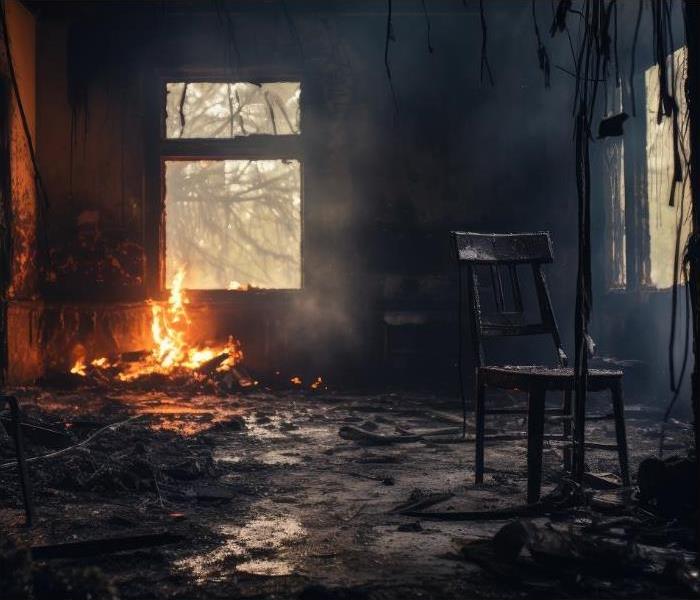 SERVPRO of Wayne is ready to help whenever disaster strikes.
SERVPRO of Wayne is ready to help whenever disaster strikes.
No homeowner wants to think about the possibility of suffering from a house fire. The sheer danger coupled with the possibility of complete destruction can keep anyone awake at night!
House fires can start in any manner of ways, but the response and cleanup process should always start as quickly as possible to prevent further issues from emerging later.
Our fire damage restoration team has the training and the tools to help you recover faster no matter the scale of your fire.
The First Phone Call
Once the fire is out and the fire trucks pull out of your drive, reality will start to set in and we assume many emotions will flood through your system. What next? Who do you call? Where do you stay?
Thankfully, a single phone call to SERVPRO of Wayne will kickstart your entire recovery. We will first obtain identifying information and ask many different questions about the fire and the damage it caused. After we compile information and gather our supplies, we will head your way to inspect the damage firsthand.
We will evaluate your home and then get right to work. Our team will secure your home to prevent further damage by boarding up windows or by tarping exposed areas of your home, and we will also assess any potential water damage issues. While fire damage can be extensive, water damage is also common at fire scenes due to the water and chemical agents used to douse the flames.
Removing the Water and Fire Damage
Once your home is secure, we will bring in air movers and blowers to dry up residual water while our fire damage restoration team will get to work on removing damaged debris. We will also identify any fragile possessions or keepsakes that need a specialized hand and remove those, too.
After the debris is gone and your space is clear, we will work on cleaning and sanitizing every area that the fire touched. We will also employ deodorizers at this time to remove any lingering smoke odor.
Meanwhile, our specialized cleaning technicians will work carefully on restoring your fragile possessions. We have specialized equipment that can help us remove stubborn smoke odors from soft materials like curtains, cushions and carpet, and we will work hard to restore as much as possible back to its original condition.
Building it Back
Now that your home is clean and ready to be restored, our construction team will take over! We are able to tackle your entire reconstruction process, even if the project requires demolition in order to rebuild certain walls or rooms.
We will hang new drywall, repair roofs or flooring and confidently tackle every aspect of your build. We will also work alongside you to make sure we are returning your home back to the way it was before the fire. Your satisfaction is our guarantee, and we won’t stop until you are 100% happy with the final product.
Don’t wait to call SERVPRO of Wayne if you suffer a house fire. We are ready to help 24/7.
What Challenges Do Wayne Homeowners Face with Fire Cleanup?
9/30/2022 (Permalink)
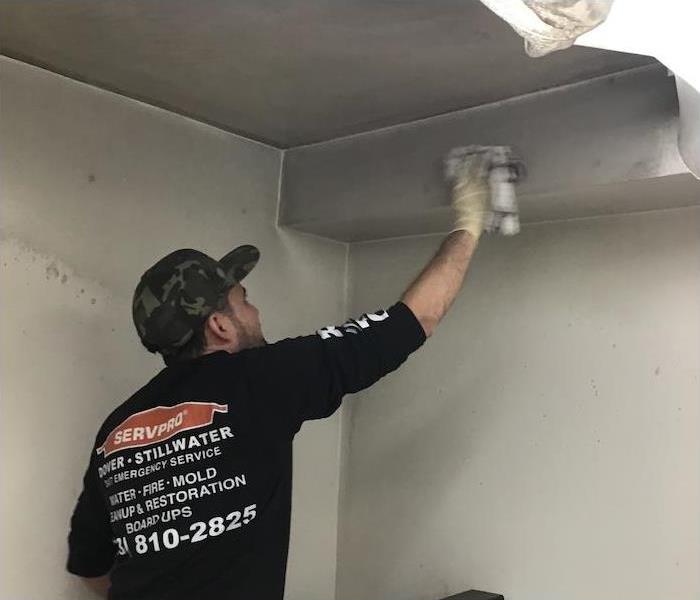 Let SERVPRO wipe away your fire damage woes in your Wayne home or business.
Let SERVPRO wipe away your fire damage woes in your Wayne home or business.
SERVPRO Fire Damage Crews Remove Soot and Soils
Home fire damage can be challenging, stressful, and overwhelming for homeowners. Soot can heavily stain and spread malodors. On top of that, structural damage that is not addressed quickly can complicate home repair and restoration tasks like HVAC cleanup. Wayne residents need a team that maximizes the availability of highly-trained technicians with quality restoration tools for soot and smoke damage mitigation.
SERVPRO provides precisely this service after Wayne homeowners experience fire damage and can return affected property and structural materials to a clean, pre-disaster state. Mitigation comes with water cleanup for fire suppression, if necessary, and sanitation with EPA-registered biocides that can remediate odor-causing bacteria and microbes.
How Fires Affect Different Substances and How Homeowners Can Prevent Them
Fire soils can leave behind a diverse array of stains, residues, and debris that require different types of care. Some items may be more cost-effective to replace instead of attempting repairs.
- Rubbers, plastics, and other synthetic, petroleum-based substances often melt and leave behind clusters of sticky residue that can smear without specialized care. These materials and oils tend to burn at lower temperatures and produce "wet" smoke.
- Unfinished wood, unsealed ceramic and masonry, and upholstery fibers are vulnerable to absorbing smoke particles because they are porous, organic substances. These stains can be a challenge to remove with consumer-grade cleaning solutions and can even cause stains to set.
- Wood and paper produce "dry," high-heat smoke when burned, and these soils are typically easier to clean.
- Metals and finished plastics with light soot stains are often restorable after fire damage, but moisture exposure can turn soot acidic.
Depending on the scale of the fire, homeowners are likely to find both wet and dry smoke residues and related debris. SERVPRO can mitigate these soils with solutions targeted at each.
SERVPRO Cleanup Addresses Various Fire Damage Soils and Odors
After fire damage occurs, homeowners are encouraged to contact their insurers as soon as possible after guaranteeing the safety of home occupants. Property owners do not have to wait for a claims adjuster to inspect the home before calling a restoration firm like SERVPRO.
SERVPRO mitigation and restoration methods can combat fire stains and soils with a diverse repertoire of tools and OSHA-approved solutions, including:
- Inspection tools for water damage caused by fire suppression, as well as HVAC inspection and manual cleaning equipment
- Specialized solutions for wet and dry fire soils, as well as solutions designed for pungent protein residues
- Odor control via thermal fogging, sanitation, soda blasting, and powerful ventilation fans, among other methods
For larger-scale fires, SERVPRO professionals can perform a pack out. This process entails carefully packing items for restoration, keeping digital and paper inventory records, and moving these belongings to an approved SERVPRO warehouse for offsite cleanup. While contents are restored at the warehouse, technicians at the residence focus on structural restoration and repairs. Once the property is clean and secured, technicians can move items back per the homeowners' wishes.
Homeowners can still access belongings while they are at the SERVPRO warehouse. The team's inventory system ensures that belongings are convenient and easy to find, with items packed per room and boxes identified with bar codes that correlate with the digital inventory system.
When you need fast-acting restoration services, We're Faster To Any Size Disaster. Contact SERVPRO of Wayne at (973) 546-4977 to begin the remediation process.
The First Steps in Dealing with West Milford Fire Damage
8/21/2022 (Permalink)
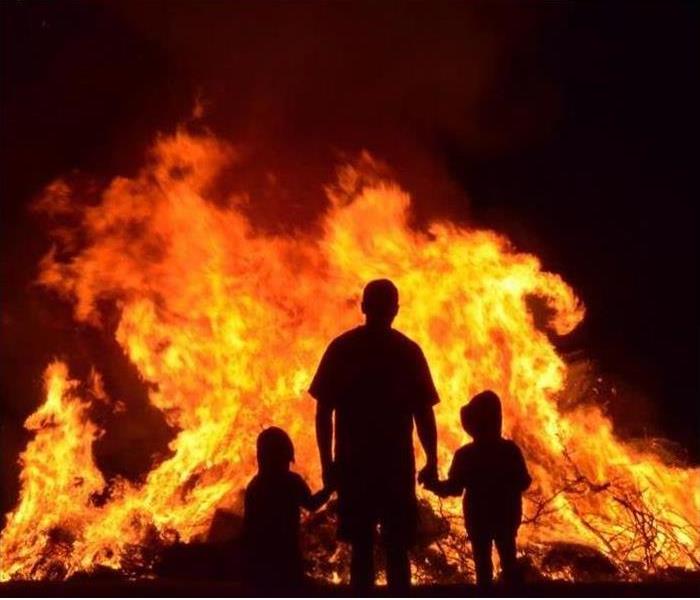 Want a "Like it never happened" cleanup to your fire damaged West Milford home? Just call SERVPRO.
Want a "Like it never happened" cleanup to your fire damaged West Milford home? Just call SERVPRO.
West Milford Smoke and Fire Restoration
When a fire happens in your family home, there is a good chance you are in a state of shock. After ensuring everyone in residence is safe, you inevitably face the daunting task of cleaning up. A fire in your home is damaging, scary, and unfortunately common. The National Fire Protection Association (NFPA) estimates over 400,000 structural fires in the United States in 2018.
If you have fire damage in your West Milford home, you should first contact professionals. SERVPRO technicians can help you at all times, day and night. We're Faster to Any Size Disaster.
The damage from blazes and smoke can be extensive, requiring professional recovery services. While you wait for the SERVPRO Technicians to arrive at your residence, there are some things you can do and some things you should avoid. Some of these points are common sense, but you may not be thinking clearly after the trauma of a fire.
Things to Do
- Make sure everyone is safe, and remember, safety first. If it is not safe to re-enter the home, you should wait. Stay in contact with the fire marshall.
- Contact your insurance company.
- Keep hands clean to avoid more damage by spreading soot and residue.
- If there is no electricity, keep the fridge door closed. Stay out of the house. The lack of power may indicate an electrical hazard.
- Double layered cheesecloth over air registers to act as a makeshift filter.
- Protect the chrome around your residence by coating it with oil or petroleum jelly to protect unique, personal items.
Things to Avoid
- Do not walk around the home. Soot particles can embed into carpets.
- Do not attempt to clean surfaces, artwork, or electrical equipment without first talking to professionals.
- Do not eat any non-perishable food items if stored near the fire.
- Do not turn on ceiling fans in case of electrical damage or to circulate soot.
When the trained SERVPRO professionals arrive, they take over, assess the damage, create an estimate for the insurance adjuster, and begin work on your home. Restoration is better than replacement; we use our cutting-edge equipment and technology to restore your home to preloss condition whenever possible. We make it "Like it never even happened."
If a fire damages your house, contact SERVPRO of Wayne at (201) 464-8981 to ensure thorough home cleanup.
What Can I Expect from Full-Service Fire Restoration in My Pompton Lakes Home?
7/27/2022 (Permalink)
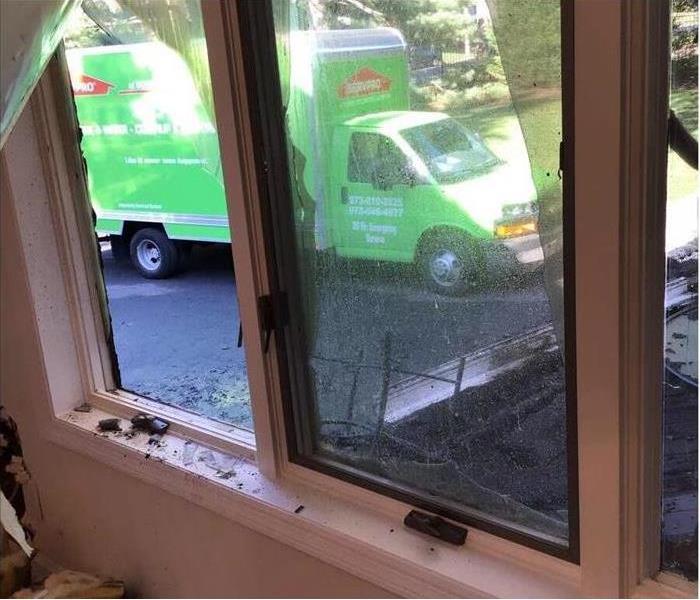 After a Pompton Lakes fire, homeowners love to see our SERVPRO Green Fleet on the Scene for Cleanup and Restoration
After a Pompton Lakes fire, homeowners love to see our SERVPRO Green Fleet on the Scene for Cleanup and Restoration
Keeping Property Owners Informed Every Step of the Way Is Crucial to How SERVPRO Completes Fire Restoration in Pompton Lakes
The property damage from a household fire in Pompton Lakes needs professional attention even if the blaze was extinguished quickly, and the harm seems minimal to your eyes. Fire damage residues move throughout your home and cause long-lasting damage and persistent deterioration if not removed fast. Restoration tasks can involve many different skilled disciplines, requiring the workers to have specific training and appropriate gear and equipment. The broad outlines of what fire damage restoration specialists manage are outlined below.
Why Is There So Much Water and What Should Be Done with It?
Although you used a chemical extinguisher to bring the flames under control, when the firefighters arrived, vast quantities of water joined the foam. Fire damage restoration in Pompton Lakes necessarily starts with water and extinguisher chemical containment and removal. Until the wet floors and collected pools of water exit the scene, other fire restoration measures cannot commence. The primary reason to bump water damage to the top of the work agenda is safety. Excess water can create many risks, including the following, which must be contained for the good of all you and your family and our workers:
- Slip, trip, and fall hazards, including charred debris impossible to see beneath contaminated waters
- Electric shock or electrocution
- Illness or injury from contaminated water
- Structural weakness and imminent collapse from water trapped over ceilings and in other building cavities
- Weakening of wood and metal framing and other structural supports such as subfloors, stairs, and door and window frames
- Disruption of hazardous building materials previously contained, such as asbestos and lead (usually on painted surfaces)
- Mold growth and damage
Can We Skip Drying to Clean Up the Smoke Residues?
The answer is negative because the damage unresolved moisture does is equal to fire damage, including the risk of mold growth if drying delays more than 24 to 48 hours. The SERVPRO team is creative, however, using the water damage phase, including drying time to evaluate soot residues and do preliminary testing to ensure the cleaning products and tools. Methodology removes tough soot coatings efficiently and safely. We can also use containment with 1.6 mil polyethylene and air scrubbers to create smaller drying sections of the house's wet areas as we remove solid particulates from the air. Our crew sizes are scalable, allowing the project manager to assign technicians with certifications in different disciplines to different phases, steps, and tasks of the overall project. Drying in water-damaged spaces happens while soot removal proceeds in rooms of the house affected by soot drift but not water and its harm.
How Is Soot Residue Removal, Unlike Typical House Cleaning?
The compounds created when building materials heat and burn can be incredibly toxic and corrosive to the surfaces affected. Smoke can linger airborne for hours to days, impairing the air quality while workers try to remove residues and begin to address persistent odors. Our crews frequently must don extensive personal protective equipment (PPE), including respirators, masks, boots, gloves, suits, face shields, and more, to work safely in affected areas. Conventional cleaning products are inadequate to remove tightly adhered soot, particularly protein-based residues from kitchen fires. We review our IICRC strategies to match different types of soot and surfaces with cleaning products, tools, and methods. This ensures the cleaning is effective but does not damage the underlying surface.
What Is That Smell? How Are Odors Managed During Fire Damage Restoration?
One of the discouraging issues experienced as fire restoration draws to a close can be lingering odors from the smoke and soot. If deep cleaning and debris disposal do not eliminate all of the malodors, we have innovative equipment and protocols that can get rid of fire damage smells for good:
- Thermal fogging -- heated deodorants disperse, recreating the fire conditions, pairing with odiferous particles to neutralize them.
- Ozone machines -- oxidation eliminates odors while occupants and pets evacuate for a short time.
- Hydroxyl generators -- created by UV light, hydroxyl radicals break down the molecular structure of odors and volatile organic compounds (VOCs)
- Sealants prevent odors from being deeply absorbed into structural components from vaporizing.
Hire SERVPRO of Wayne with complete confidence for fire restoration. We are trained, experienced, and well-equipped, available today, tomorrow, and into the future for your concerns and questions at (973) 546-4977.
House Conditions Change Wayne Fire Restoration
7/27/2022 (Permalink)
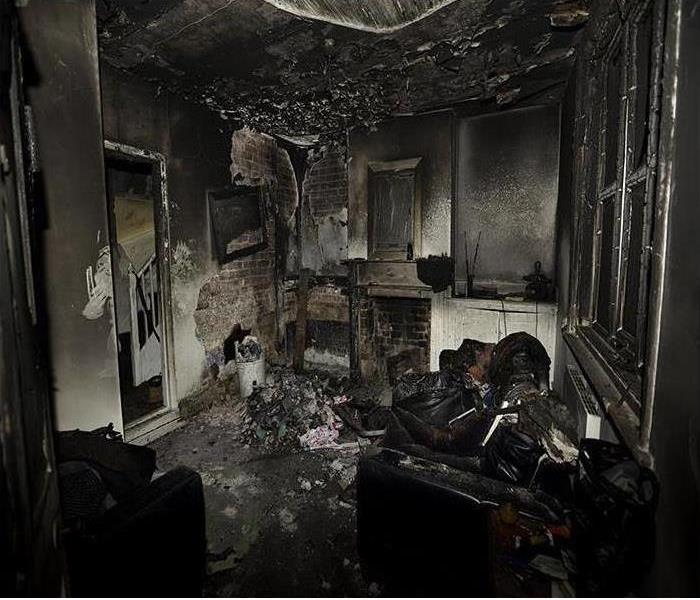 We aim to restore your property as quickly as possible, “Like it never even happened.”
We aim to restore your property as quickly as possible, “Like it never even happened.”
What Makes Fire Restoration a Challenge?
Fire loss situations are a destructive presence in your home. Depending on several variables like the location of the fire and the kind of materials impacted by combustion, the needed restoration and recovery strategies must change.
What Factors Influence the Smoke Damage?
The type of smoke damage and various environmental factors can significantly change the needed fire restoration for Wayne homes. Some of the variables that can ultimately influence the ease and needed cleaning approaches for fire-damaged structural elements and contents include:
- Temperature – While higher heat can produce thinner residual aftermath, these warmer temperatures during the blaze also open up pores in building materials more for more significant infiltration of smoke effects.
- Obstructions – Physical obstructions and blockages in the house can slow the migration of smoke and soot damage. While a closed door will not stop smoke movement entirely, this obstruction can greatly slow turbulent air movement.
- Environmental Factors – The conditions of the house itself are also factors in the needed restoration and cleaning. Impacted materials, humidity, and the home's layout all influence required repair.
Clearing Smoke Damage from Walls
When you determine the factors influencing the cleaning of the soot and smoke residues a fire can leave behind, it is time to start this recovery phase. We have several approaches that can often work together to achieve the complete restoration and salvaging of most building elements:
- Cleaning the Surface – We choose several products to emulsify, dissolve, or trap soils.
- Agitation and Mechanical Action – Mechanical actions like scrubbing can help activate the cleaning properties of chosen agents.
- Tactics of Abrasive Cleaning – Abrasive cleaning involves putting media like dry ice or sodium bicarbonate under pressurized water or air to remove set-in soot stains.
- Controlled Demolition – If surface cleaning or more abrasive methods are ineffective, the remaining choice is to remove damaged materials entirely.
You can count on our SERVPRO of Wayne team for fast and knowledgeable fire restoration. Give our FSRT-Certified technicians a call today at (973) 546-4977.
We Have The Experience And Expertise Necessary To Restore Your Wayne Home After A Fire
5/26/2022 (Permalink)
 A puff-back occurs when a furnace misfires and pushes smoke throughout the house. Our technicians are trained to detail clean your home.
A puff-back occurs when a furnace misfires and pushes smoke throughout the house. Our technicians are trained to detail clean your home.
How Does Soot Affect Your Wayne Home?
For as typical as the presence of soot might be after a Wayne housefire, there is still a great deal that homeowners do not know about this substance and how it can affect their properties. The better informed you can become about this threat, the more likely you will appreciate the training and industry-leading equipment available to our professionals. We know the risks of soot exposure and want our potential customers to understand it.
We know that our SERVPRO team might not always be the choice that residents make to overcome fire damage in Wayne homes. However, we still want to help people get their homes and businesses back to their original condition regardless. Part of what our team does with any recovery effort is to help educate our clients about the work happening and why specific steps are necessary to return your house to a pre-damaged state.
Soot might appear as a black residue on surfaces throughout your home. You should presumably be able to wipe clean with soap and water, but this is seldom the case. There are multiple fire damages that this residue can allow, and the first of these occurs when uninformed residents attempt to clean the substance using conventional approaches. Smearing and staining are typical of inadequate cleaning practices.
Because soot particulates are light and powdery in many cases, they can spread to surfaces like ceilings and attach themselves throughout the ducts of an HVAC system traveling from one affected room to another. Soot particles can often be difficult to see circulating in your home.
Our SERVPRO professionals also aim to educate our customers and neighbors on the acidity of soot residue. For surfaces that could become coated with the soot susceptible to these damaging conditions, like the metal of ductwork, pipes, and other metal materials throughout your house, corrosion can be a costly secondary effect of soot exposure.
No matter if you choose our qualified and trained SERVPRO of Wayne professionals or not, we are here to help you overcome fire effects however you need us. We have years of experience that works to restore properties or provide an expert-level second opinion. Give us a call anytime at (973) 546-4977.
Tailored Fire Restoration Plans for Wayne Homes
5/26/2022 (Permalink)
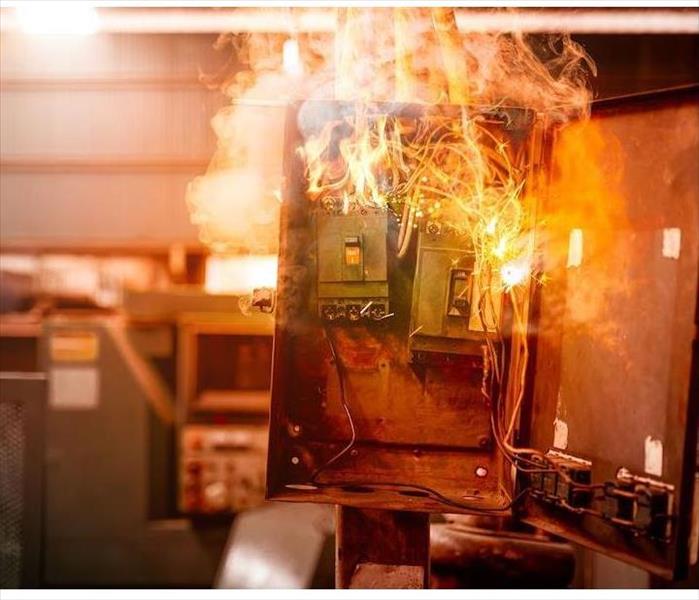 Call the professionals at SERVPRO of Wayne (973) 546-4977 to help with fire restoration to your property.
Call the professionals at SERVPRO of Wayne (973) 546-4977 to help with fire restoration to your property.
SERVPRO Laundry Room Fire Cleanup Services
Kitchens are not the only area of a Wayne property vulnerable to fire. Ignition can happen anywhere and anytime, even in a home's laundry room. Electrical failures–one of the most likely causes of laundry room fires–can be exacerbated by the presence of dust, prolonged use of extension cables, and malfunctioning dryer parts.
SERVPRO fire restoration specialists return Wayne properties to a pre-fire condition 24 hours a day, even during holidays and weekends. Emergency responsiveness is necessary to preserve as much as possible after a home fire.
Restoring Fire Damaged Laundry Room with SERVPRO Tools and Techniques
SERVPRO fire cleanup strategies may include:
- Drying any residual water damage from fire suppression with extractors, air movers, and dehumidifiers
- Removing light soot from appliances and structural surfaces with dry cleaning sponges and EPA-registered detergents
- Preserving clothing and other salvageable fibers with the help of compressed air, odor counteractants, and thermal fogging.
- Demolishing unsalvageable flooring, baseboards, and damaged drywall to implement structural repairs
- Using heavy-duty solutions and abrasion cleaning on charring and hard-to-remove soils where appropriate
Tile flooring is often salvageable after a fire, but grout may require repairs if not sealed thoroughly. Technicians can also establish negative air pressure with HEPA-filter air scrubbers to trap soot in contained areas. These particles are collected with commercial-grade vacuums that feature HEPA filters, which can catch particles as minute as 0.3 microns.
Ductwork also requires cleaning in many cases after a fire. Flex ducts used for dryer ventilation or HVAC typically need replacement. In contrast, duct board and sheet metal are more likely to be restorable with the help of ultra-low volume foggers, agitation tools, and OSHA-approved antimicrobials.
Property owners are encouraged to contact SERVPRO of Wayne at (973) 546-4977 for restoration that looks and feels "Like it never even happened."
We Are The Fire Damage Restoration Team You Can Trust In Wayne
4/7/2022 (Permalink)
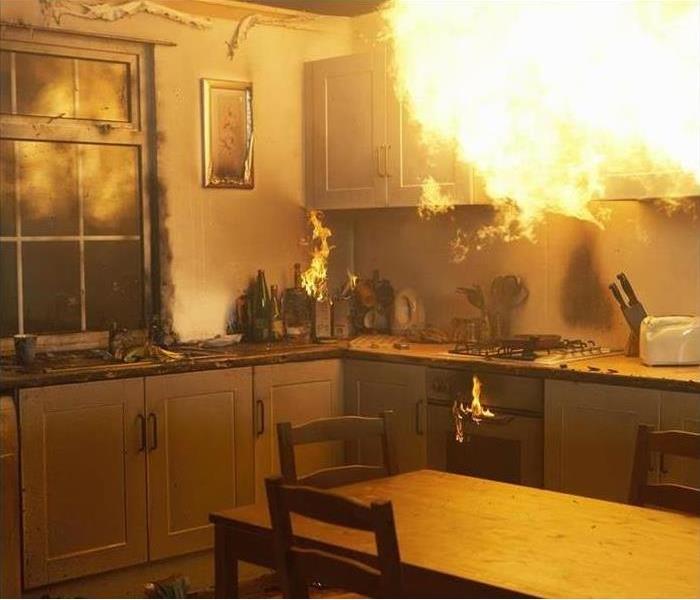 We are here for you 24/7 to offer our experience, expertise and equipment so you can get back to normal living in your home after a fire.
We are here for you 24/7 to offer our experience, expertise and equipment so you can get back to normal living in your home after a fire.
Professional Odor Control for Fire Damage in your Wayne Property
Using a professional restorer is valuable to homeowners because of their ability to neutralize odors rather than just masking them with household air fresheners. Minor property fires can still cause extensive odor issues. This problem is due to smoke traveling beyond the containment area, entering ventilation systems, and depositing residues throughout the home. We train our technicians to trace smoke from the source and apply advanced odor control techniques to restore your home.
Odor control services are essential for homeowners that have fire damage in Wayne. Even a tiny property fire can be a traumatic event, and the smells left behind are an unpleasant reminder. SERVPRO technicians understand how smoke migrates through a property which allows us to find and remediate the source. By tackling the problem at the source, we can be confident that odors do not return once the service is complete.
As a general rule of thumb, odor mitigation is most effective when the deodorant is dispersed in a similar way to the odor. For fires, the distribution of odors comes from two sources. The first is through smoke, which can travel on air currents leaving smelly deposits wherever it comes into contact with surfaces. The second is by soots dropping down and being absorbed by fabrics, an issue that can be exacerbated by moisture used in firefighting efforts.
Furnishings and fabrics can often be expensive to replace. SERVPRO uses solvent-based deodorants that can be sprayed onto surfaces. These are more powerful air fresheners that cover the smell until the odor particles have dispersed enough to be no longer noticeable. We can combine this method with cleaning to ensure no soot and soiling is removed from surfaces.
Once smoke enters a ventilation shaft, cavity or crawlspace, it can quickly spread around the home. These are difficult issues to remediate since areas like this are hard to reach. SERVPRO can mobilize thermal foggers. These turn solvents into vapor which is then distributed throughout the home. The solvents we use in thermal foggers are chemical pairing agents. They bond with odor particles neutralizing them or causing them to sink to the floor where they can be cleaned away after fire damage.
Get rid of stubborn odors after property damage; contact SERVPRO of Wayne at (973) 546-4977.
Steps for Restoring Wood After Fire Damage in Your Wayne Home
10/14/2021 (Permalink)
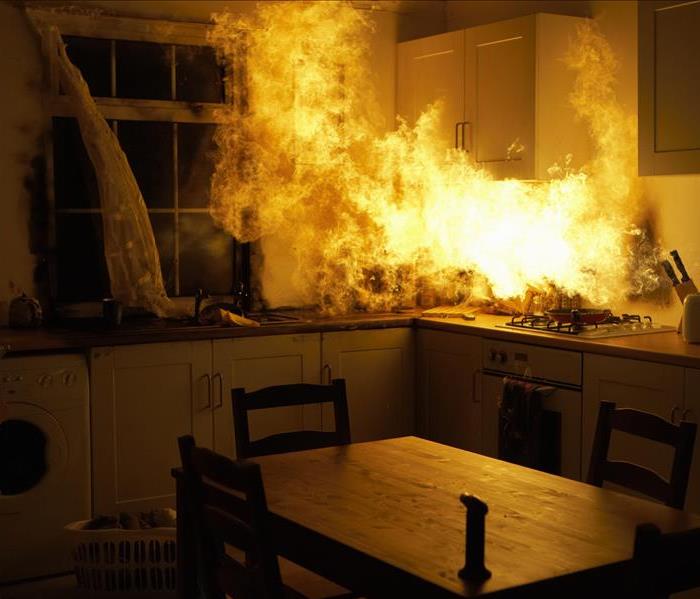 SERVPRO is an EPA-registered company. We have the manpower and equipment for any fire-damaged restoration service needed.
SERVPRO is an EPA-registered company. We have the manpower and equipment for any fire-damaged restoration service needed.
Treating Wood Floors and Affected Items After a Fire In Your Wayne Home
A fire in your Wayne home can ruin many different items and building materials. Soot can destroy wooden things and floors. Cleaning up soot damage on wooden structures and contents can be challenging. Since wood is a naturally porous material, smoke and smells can permeate the surface.
To restore wood, you may need to use aggressive cleaning and deodorization methods. Consulting with SERVPRO restoration technicians to deal with the fire damage in your Wayne residence is therefore essential. We can control the results by pretesting the affected area, using the right cleaning agents, and using the correct dilution rates of cleaning solutions. Our technicians use professional cleaning products and strategies to provide our customers with the best chance of restoring the affected surfaces completely.
Our professional restorers are usually tasked with restoring two types of wood. To remove soot, each kind of wood requires specific procedures and products.
Finished Wood
This is wood that is covered in varnish or a sealer. Most kinds of wood furniture like dressers, desks, railings, and tables, among others, are finished wood pieces. To clean up soot on these kinds of surfaces, we can gently work a cleaning agent into the grain of the wood, where it suspends the soils allowing for easy removal.
Unfinished Wood
This kind of wood does not have a sealer or varnish, and it can easily sustain damage from smoke smells and staining from soot. Generally, unfinished wood includes structural timber and the inner parts of cabinets and drawers. Unfinished wood is also susceptible to water stains. Therefore, our restorers are careful to prevent such stains during the cleaning and restoration process.
If the fire has ruined your wood flooring, our technicians can try to remove the smoke residues without damaging the floor’s finish. To remove light to moderate residues, we can damp mop the floors using a neutral pH cleaner.
In many cases, it is necessary to seal the surface of the wood, whether it is unfinished or finished, to lock away the odors that remain after using other deodorization methods. We can use sealants to achieve this. Our SERVPRO team applies sealants to the affected surface to encapsulate the remaining odor residues. We offer exceptional workmanship and have all the tools, equipment, and materials that ensure a seamless and smooth restoration.
Where a fire has ruined furniture and other wooden contents or structures in your home, you can trust SERVPRO of Wayne to bring things back to normal. Call us any time at (973) 546-4977 for fire restoration services in West Milford, Pompton Lakes, and Ringwood.
Debris and Fire Damage Restoration in Wayne – Call SERVPRO
9/30/2021 (Permalink)
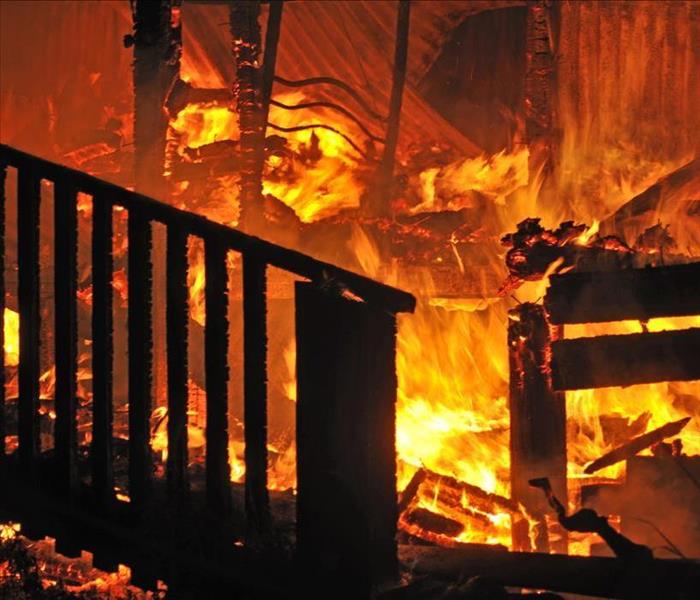 Fire and soot removal is not a DIY project. SERVPRO fire damage restoration technicians have the technology and experience for any size disaster.
Fire and soot removal is not a DIY project. SERVPRO fire damage restoration technicians have the technology and experience for any size disaster.
Removing Debris and Smoke Residues After a Fire in Wayne – Call SERVPRO
After the fire is extinguished at your home in Wayne, there often is extensive debris, water damage, and smoke residues throughout the premises. While the debris may be contained to the immediate location of the fire, water used to quell the fire has spread to other rooms nearby and below. Smoke particles carried by the home's heating and cooling system and hot air currents caused by the fire may distribute smoke odors to every room.
SERVPRO provides fire damage restoration in Wayne and surrounding areas. We remove debris from the fire, ash, and smoke residues from floors and building materials as well as from your contents. Many hard surface materials, including contents, can be washed, cleaned, and dried. Your cleaned contents are stored in a staging area until the entire home is ready for occupancy.
Many soft surface materials, including fabrics, can also be cleaned; however, we will review our recommendations for cleaning vs. replacing with you and your insurance company to ensure the best solution for your fire damage situation. We attempt to clean everything when possible to remove the odors and soot left over after a fire.
We arrive at your home in less than four hours from your call, assess the damage, confirm that it is safe to enter the house, determine the equipment and resources needed to begin restoring your home after a fire. We also provide emergency board-up and tarpaulin coverage to prevent further damage to the house if required.
SERVPRO provides the following services to our clients:
- Fire damage restoration
- Water damage restoration
- Smoke residue remediation and restoration
- Debris removal and house fire clean up
Call SERVPRO of Wayne for fire damage restoration services in Wayne and surrounding areas. We can help 24/7. Call (973) 546-4977.
Fire Damage in Wayne? SERVPRO Can Lead you Through the Restoration Process
9/8/2021 (Permalink)
 Even small fires deposit smoke and soot throughout the home. SERVPRO is always on call for complete fire damage restoration.
Even small fires deposit smoke and soot throughout the home. SERVPRO is always on call for complete fire damage restoration.
Assessing Fire Damage in Wayne to Determine the Next Steps
The structure of your Wayne home can take on significant damage during a fire. All your personal belongings and cherished heirlooms can also suffer from the heat of the flames and smoke penetration. A SERVPRO crew can come in to address your needs for remediation as well as all of the restoration costs involved to get your interior back to normal.
We have a variety of methods that can be used to clean any soiled household items when soot and fire damage in Wayne occurs. Once you call us, we can send a team out to sort through your belongings, placing them into groups. Our team categorizes according to the damage sustained as well as the type of material.
Assessing Fire Damage
Our technicians separate Items that need wiping down or simple cleaning into one group. These are usually items that may require cleaning with a dry sponge or a gentle cleaning followed by a rinse. Such methods work best on dishes, fine china, and other non-porous materials. Lightly vacuuming cleans items like books, and rugs and carpeting require adequate restoration using soot-battling agents.
For the electronic equipment in your home, our building department can work to identify fire damage caused by soot deposits, heat, smoke, and water from the firefighting process. SERVPRO recommends turning on none of your electronics until they are thoroughly examined to help eliminate the chance of a short that can lead to permanent damage.
We can treat some possessions in your home at our facility, which we put into boxes to help protect from breaking during transport and storage. A sheet with detailed inventory for each box is used to ensure all of your items get returned to you after fire damage remediation. This CCIS Contents Claim Inventory Service catalogs non-salvageable items and helps for pack-outs for content cleaning off-site at our facility.
You can count on our trained professionals at SERVPRO of Wayne whenever you need help after suffering a fire loss. Contact us anytime at (973) 546-4977 for all of your fire and water cleanup and restoration needs.
What Emergency Services Begin Fire Restoration in Wayne Homes?
7/28/2021 (Permalink)
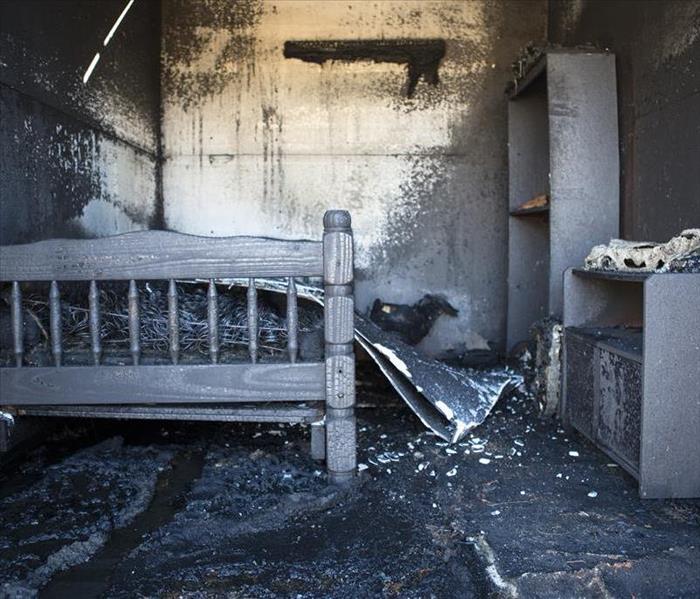 SERVPRO of Wayne knows what fire damage can do long term. Let us come in and help.
SERVPRO of Wayne knows what fire damage can do long term. Let us come in and help.
Our fast response ensures that we can begin fire mitigation in Wayne houses immediately.
Mitigation is the process most critical to restoring your home after a fire. Several actions fit in this heading and require the full experience and education of our SERVPRO team.
What Are Some of the Common Mitigation Actions?
Overcoming fire damage in Wayne homes starts with:
- Controlled Demolition – After structure fires, some degree of demolition and reconstruction is necessary. Removing hazards from the property through controlled demolition also provides a stable foundation for reconstruction.
- Debris Removal – Eliminating loose debris, charred material remnants, and ash from the property reduce the severity of effects like smoke odors or soot concentrations.
- Air Quality Improvement – Soot and smoke solids circulate in the environment after partial combustion. We utilize HEPA 500 Air Scrubbers and other filtration equipment to trap particles and prevent health hazards from persisting.
- Content Relocation – Removing affected items in your home can be a method of keeping your belongings safe from further damage. Setting up a safe space for these items until restoration completes can be a cost-efficient solution.
- Water Removal – Water damage is a common damaging situation after fire extinguishment. The water used in putting out a fire can collect on flooring and in structural cavities. Fire mitigation requires efficient extraction of this standing water.
For fire restoration you can trust, give our SERVPRO of Wayne team a call today at (973) 546-4977.
Our Certified Professionals Are Ready to Handle Your Fire Damage Restoration Needs in Wayne
7/8/2021 (Permalink)
 Structural fire damage in Wayne properties calls for the professionalism of SERVPRO cleanup and restoration
Structural fire damage in Wayne properties calls for the professionalism of SERVPRO cleanup and restoration
What to Expect from Professional Fire Damage Restoration Technicians
A fire in your Wayne residence leaves contaminated water, soot-soiled surfaces, charring, and odors. Airborne and surface-coating residues of even a minor fire immediately begin discoloring and damaging building materials and possessions. More significant blazes can damage the structural integrity of your house and create substantial barriers to returning to your comfortable life. Our compassionate and skilled team of fire remediation specialists can make this chaotic situation “Like it never even happened.”
Managing fire damage restoration in Wayne requires a committed and highly-trained professional team and state-of-the-art products and equipment. Since both the structure and the contents of your home suffer damage, partnering with a company that can accomplish a pack-out of portable articles is critical. We use a Contents Claim Inventory Service (CCIS) protocol to ensure a complete inventory and tracking of contents packed out. Once the affected areas in your home clear, we can more easily perform necessary remediation tasks.
House Fire Clean Up
SERVPRO’s experienced production and crew managers and leads assess the damage, plan the remediation, and oversee the various stages of the project. Our service vehicles arrive stocked with water and fire remediation equipment, avoiding delays. Safety always comes first, so we secure the building, tarping and boarding up if necessary. Removing water damage from the firefighting efforts and drying proceeds next.
Evaluation of the type of soot and matching appropriate products and tools guides our crew during clean-up. Light, ashy debris vacuum or dry sponge away. Thick, sticky soot from slow smoldering fires needs cleaning with wetting agents, surfactants, and agitation. Protein-based soot might require solvents and abrasives.
Charred areas might restore if the burned areas are shallow, but we constantly assess for strength to ensure your home retains its structural integrity. If necessary, we remove and replace materials, relying on the skills of our rebuilding crew. SERVPRO deodorization experts walk through a multi-step protocol to eliminate rather than cover up odors. Professional grade thermal foggers, ozone machines, and hydroxyl generators are available for challenging odor issues.
While our crews remediate and restore your home, our production facility technicians use specialized strategies to clean and restore your packed-out furnishings and other contents. We facilitate their return to your home at the appropriate time. SERVPRO works closely with your insurance throughout, limiting your out-of-pocket expense for both structural and content restoration.
SERVPRO of Wayne stands ready to restore your home and its contents after fire damage. Call us 24/7 at (973) 546-4977 to set up an assessment.
What Fire Restoration Services are Available in Wayne?
6/20/2021 (Permalink)
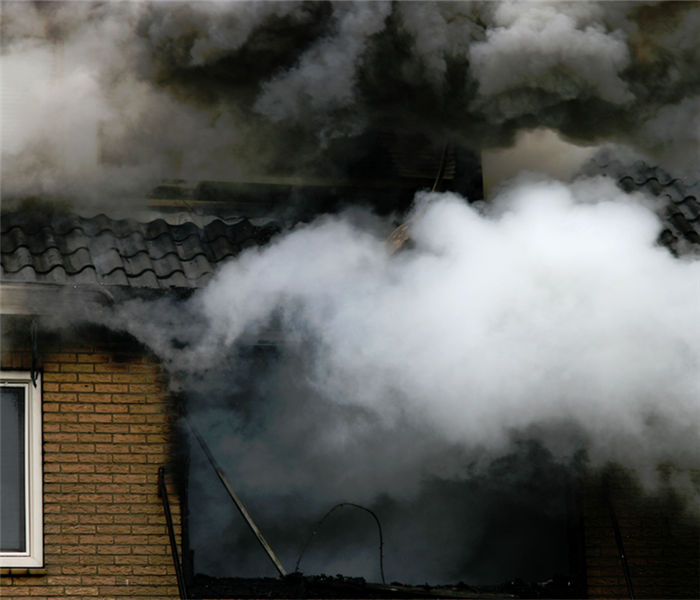 Fire clean up needs to be done quickly and effectively. Contact our certified SERVPRO technicians to remediate the fire damage in your home.
Fire clean up needs to be done quickly and effectively. Contact our certified SERVPRO technicians to remediate the fire damage in your home.
In Wayne, Companies Like SERVPRO Offer a Broad Array of Fire Restoration Services
Fire-related incidents are relatively common in Wayne, so it is a good idea to prepare for potential house fires. Fortunately, when disaster strikes, local services like SERVPRO are always ready to restore fire damaged homes.
SERVPRO technicians routinely perform fire restoration work in Wayne. While doing their work, our highly-trained experts employ all the latest and most advanced equipment. This is partly why our company has successfully handled a wide range of jobs from the least to the most severe.
A few of the valuable services we offer are:
- House fire clean up that professionally clears away fire-related debris from your home and properly disposes of it
- Fire and smoke damage remediation using state-of-the-art air scrubbers, ozone machines, wet, dry, abrasive, and innovative smoke residue cleaning methods, and advanced foggers with EPA-approved deodorants
- Fire damage restoration that skillfully seeks to save salvageable materials and rebuilds whatever has been irreparably damaged
So, as you can see, whatever fire-related issues you may have suffered, our skilled professionals are likely able to deal with. We can help you throughout the entire fire recovery process, from the initial clean-up through the restoration or reconstruction phase.
With all this in mind, if your home ever experiences a fire, remember that there is help nearby. Call SERVPRO of Wayne anytime at (973) 546-4977 for fast assistance.
Take Some Time for Self-Care in Pompton Lakes
12/7/2020 (Permalink)
 SERVPRO of Wayne agrees it is good to take some time for self-care.
SERVPRO of Wayne agrees it is good to take some time for self-care.
Virtual Wellness Workshops Encourage Health and Relaxation for Pompton Lakes Residents
Pompton Lakes homeowners are cordially invited to join a specialized health expert once a month for a Talbott Recovery virtual event focused on improving individuals’ well-being through education. Each month, wellness experts and professionals in the field take an hour to talk to audiences about the various aspects of health and wellness.
Topics covered during these monthly lectures include:
- Spirituality
- Social and physical health
- Emotional well-being
Talbott’s November virtual workshop was presented by Jana Burbato, who is a Certified Holistic Health Practitioner, Certified Pilates Reformer Instructor, and Certified Yoga Instructor. Burbato is also currently the Director of Talbott Recovery Campus’s Business Development department, and has over a decade of healthcare industry experience.
The upcoming December 16 Wellness Wednesday takes place from noon to 1:00 p.m. Eastern Standard Time.
SERVPRO of Wayne renders fire damage restoration services for Pompton Lakes homes within hours of your initial contact. Call (973) 546-4977 to begin the cleanup process.
Make Happy and Lasting Holiday Memories this Christmas at Willowbrook in Wayne
11/24/2020 (Permalink)
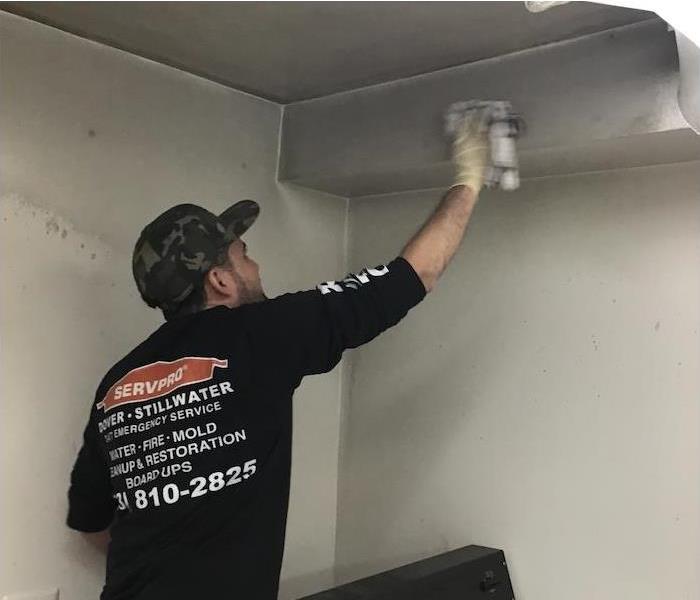 Let SERVPRO wipe away your fire damage woes.
Let SERVPRO wipe away your fire damage woes.
Wayne Families Count on Photos with Santa and Willowbrook Mall Ensures You Can Continue a Treasured Tradition
Sleigh Bells ring in the Bloomingdale Exhibit Court at Willowbrook this holiday season. Santa is ready for his close up with kids of all ages from the Wayne area. This season reservations are a must, allowing you and your family to plan your professional photoshoot without the worry or bother of waiting in long lines. Please choose a time to meet with Santa that works best for you and your family, and schedule it through Willowbrook’s website.
Dates and Times:
Now through December 23
Mondays -- Saturdays 11 am -- 7 pm
Sundays -- 12 pm -- 6 pm
December 24 -- 9 am to 5 pm
If your home needs fire or smoke restoration during the busy holidays, you can feel confident when you schedule an assessment with SERVPRO of Wayne. One call to (973) 546-4977 is all it takes to make it “Like it never even happened,” before welcoming family and friends.
Emergency-Response Restoration Services in Wayne
11/23/2020 (Permalink)
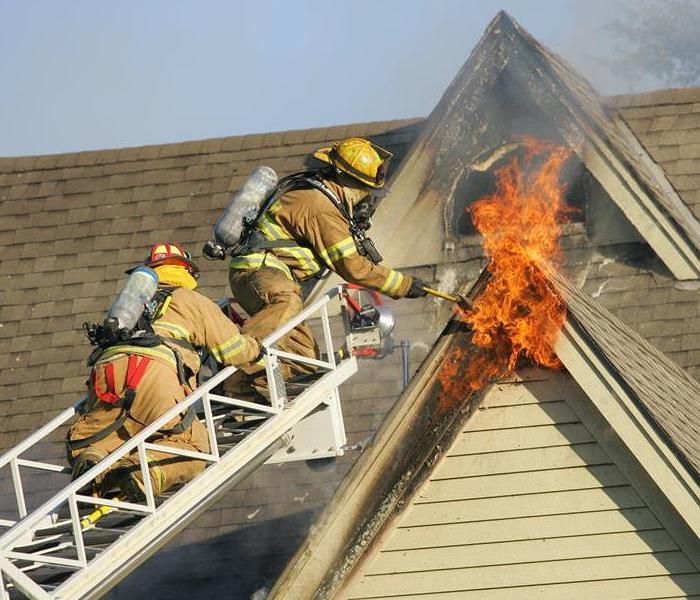 SERVPRO of Wayne is ready for your fire damage emergency call.
SERVPRO of Wayne is ready for your fire damage emergency call.
SERVPRO of Wayne is a Phone Call Away from Rapid Disaster Cleanup at (973) 546-4977
Wayne, New Jersey’s history begins in 1694 with the land surveying and speculation of Arent Schuyler. Schuyler was tasked by the British with investigating rumors of French-led rebellion among the local Lenape tribespeople. However, the Lenape proved to be a peaceful agrarian tribe in a fertile river valley.
In 1695, Schuyler and many others, including Samuel Bayard and Anthony Brockholst, decided to invest in the land and eventually purchase it as British territory. At the end of the year, the first township settled on the newly purchased 5000 acres of land was dubbed New Barbadoes Township. The area would not be incorporated as Wayne until April 1847. The historic Schuyler-Colfax House on what is now Hamburg Turnpike still stands today as a museum and a testament to centuries of Wayne area history.
Notable people from Wayne include:
- Retired United States Army North commanding general Major General Guy C. Swan III
- Members of the band Dramarama, including founding member and bassist Chris Carter, singer John Easdale, keyboardist Theodore Ellenis, guitarist Mark Englert, and drummers Ronny Machuga and Jesse Farbman
- A-list actress and “Queen of Jazz-Rap” Dana Owens, also known as Queen Latifah
- New York Jets tight end Chris Pantale
- Real Housewives of New Jersey stars Kathy Wakile and Danielle Staub
- Paterson State alumnus Steve Lamprou
Wayne’s Revolutionary History
New Barbadoes Township, which was part of Saddle River Township by the 18th century, was nearing a century in age by the American Revolution. The Wayne area played a key role for prominent figures in the American Colonial Army, including:
- George Washington, who formed his headquarters at Dey Mansion in the summer and autumn of 1780 and resided there with Alexander Hamilton
- Anthony Wayne, the town’s namesake and the fifth Senior Officer of the United States Army, whose military tactics earned him the nickname “Mad Anthony”
- Gilbert du Motier, the Marquis de Lafayette, a French nobleman and officer who aided American forces during such instrumental battles as Yorktown and Gloucester
Today, the Dey Mansion is a museum dedicated to preserving a unique and crucial moment in the American Revolution’s history. While it usually hosts a bevy of programs year-round, it is currently closed in response to public health concerns.
Marquis de Lafayette’s residence, the Van Saun House, is currently a private residence but is a well-preserved display of Colonial architecture. It was posted for sale as recently as January 2019 and was sold by March of 2020.
Other Revolutionary War sites for American history buffs to visit include the Wayne Public Library’s Boulder Monument, the Colfax Family’s burial plot, and the site markers for two encampments along Two Bridges Road near the Passaic River.
The Wayne Fire Department
Dealing with fires in any community is an unforeseen challenge that has a wide-reaching impact. In Wayne, fire suppression is carried out by five volunteer companies: Community Fire Company Number 1, Property Owner League Fire Company Number 2, Pompton Falls Fire Company Number 3, Preakness Fire Company Number 4, and Packanack Lake Fire Company Number 5. Each company operates independently, but the department is headed by a Fire Commissioner appointed by the mayor and elected by the firefighters.
The fire department structure is comprised of volunteer service members, with those among the most skilled belonging to the Special Emergency Response Team (SERT). SERT members take care of the most daunting tasks in a fire situation, including rescues in close quarters and other high-risk scenarios.
Both the fire department and First Aid Squad are open to new volunteers. Besides saving the community in taxes and protecting the community, active volunteer emergency service staff receive the following benefits:
- Passaic County educational facility tuition reimbursement for volunteers and their families
- Annual clothing allowance
- Access to LOSAP, an annual $1350 annual deposit in a tax-deferred income account for employees who meet the necessary point requirements
- Free access to local swimming facilities
Training for fighting is done in-house after new members have passed firefighter I and II courses at the Passaic County Fire Academy. Applicants for the department must be between ages 18 and 45, pass a background check and a physical, and live in Wayne for at least six months.
What Factors Does SERVPRO Consider When Planning Wayne Fire Damage Cleanup?
SERVPRO performs fire damage cleanup and restoration for Wayne properties that conform to the Institute of Inspection Cleaning and Restoration Certification’s (IICRC) guidelines. Restoration industry standards require mitigation teams to carefully plan their cleanup to minimize property loss and increase restoration potential.
When planning the best course of action for a fire damage situation, SERVPRO teams consider the following:
- Is there water damage from fire suppression? If so, this needs to be mitigated first. Not only can moisture allow mold and microbes to increase, but it can also make soot corrosive
- What residues are present? Burnt soils can have different characteristics that can add additional challenges to cleaning. Proteins in meat require different cleanup methods from burnt electrical appliances or charred dining chairs
- Are damaged items repairable, or is replacement necessary? While repair is a feasible option for many materials in the home, some materials, such as drywall or laminate flooring, would be safer and more cost-effective to replace than repair. SERVPRO professionals coordinate with homeowners and insurance adjusters to determine the most suitable options to return homes to a preloss state
SERVPRO also performs building and repair services for fire-damaged homes, including HVAC system cleanup, hardwood flooring repairs, roof repairs, and painting.
SERVPRO of Wayne provides restoration services that make homes look and feel, “Like it never even happened.” Property owners can call the team at (973) 546-4977 at any time of the day or night for their mitigation needs.
What Are Some Useful Things to Know When Planning Fire Restoration?
9/29/2020 (Permalink)
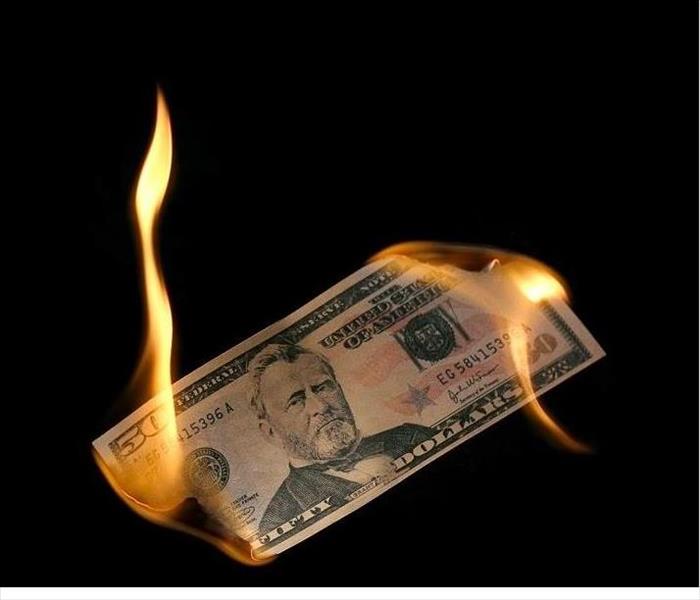 Fire damage restoration is expensive. SERVPRO knows how to restore your home cost efficiently.
Fire damage restoration is expensive. SERVPRO knows how to restore your home cost efficiently.
From the Vast Experiences Handling Fire Damage Restoration Exercises in Wayne, SERVPRO Can Guide Homeowners on What to Do
Restoring a fire-damaged property takes several processes to deal with damaged materials, soiled areas, and other problems. Although each situation may have unique requirements, loss incidents also share common characteristics. Knowing specific things can help deliver better results. When SERVPRO technicians inspect Wayne properties after fire incidents, we can help point out crucial things that the owners need to know.
What information does SERVPRO reveal about fire damage restoration to Wayne homeowners?
- Cleaning contents and structural items may differ even when involving similar materials
- Restorative processes should exhaust mild methods before trying harsh ones
- Restoration must address the interior and exterior house sections, as well as assemblies
- Materials can determine the usefulness of restorative procedures
A significant percentage of the restoration processes done after fire damage in Wayne involves cleanup of affected contents and building materials. Generally, cleaning methods depend on the type of soil and the type of material involved. However, whether you are dealing with a material that is part of the structure or contents can influence the decisions you make. For instance, if an item in your content inventory proves challenging to clean, you can move it to offsite storage until it is convenient to do the cleanup. However, issues with structural items must be addressed holistically.
It is possible to use several cleaning approaches to accomplish the same goal. For instance, removing smoke residues from surfaces can be achieved through vacuuming, wet wiping, pressure washing, or using abrasive techniques such as sanding. However, starting with mild methods presents many advantages, including faster completion of the task and lower cost. Our SERVPRO technicians opt for approaches such as vacuuming the soiled surface and wiping with chemical sponges instead of pressure washing, which can over-wet the materials leading to other complications. We only use the advanced cleaning methods where we determine the soiling is too severe. We explore cleaning before opting for different approaches such as resurfacing or teardown of materials.
What are some of the advanced cleaning methods commonly used during fire restoration?
- Peroxide active cleaning
- Soda blasting
- Abrading surfaces with steel wool pads
- Wet cleaning with alkaline or acid solutions
With the sophisticated systems, it is possible to care for the specific type of soiling or unique materials that need extra care during restoration. For instance, soda blasting can remove massive soot deposits from unfinished wood surfaces such as trusses. Peroxide active cleaning, on the other hand, is excellent for restoring acoustic tiles.
Should all sections of a house receive the same level of attention?
When a fire damages your Wayne house, you are likely to worry about the damage to interior surfaces such as walls and ceilings. You will also probably notice damage to the eaves and exterior walls and thus think of ways to address it. However, the process is not complete. Even hidden areas such as wall cavities and assemblies such as cabinets need attention. Smoke tends to collect in such places since hot smoke and other gases filter inside to replace the colder air trapped there. Therefore, even when there are no physical damage signs, there is a need to open the cavities for cleaning.
Our SERVPRO technicians are better suited for the cleaning tasks involving assemblies and structural cavities. Apart from having the sophisticated cleaning equipment, we also bring the small tools that help simplify the process of opening up hidden areas at the loss site:
- Pry bars
- Rubber hammers
- Molding lifters
- Flashlights
Do confusing situations arise during the restoration of fire damage?
You might think that once you identify the areas affected by the fire, it is easy to decide whether to perform restoration or to remove the affected materials for disposal. However, in practice, you might find yourself stuck, not because there are no solutions, but because you cannot make a decision. The damage to some contents in the house can complicate decision making if it is not bad enough to warrant immediate disposal. At the same time, it might seem too extensive to guarantee a positive outcome from the restoration. Our SERVPRO technicians help classify such items as questionable, which allows them to be set aside until there is an opportunity to examine them thoroughly and decide the best course of action.
Various unexpected issues might crop up during the restoration of your fire-damaged property. SERVPRO of Wayne sends experienced technicians to West Milford, Pompton Lakes, or Ringwood properties to help manage unexpected issues. Call us at (973) 546-4977. We're Faster To Any Size Disaster.
Who Do I Call after a Fire in My Home Left a Mess Behind?
9/1/2020 (Permalink)
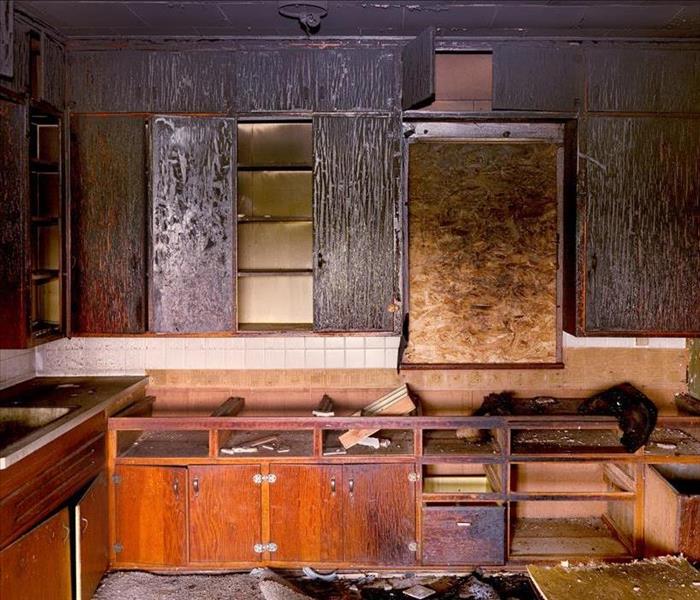 This is not a DIY fire damaged kitchen in Pompton Lakes! Call SERVPRO for professional cleanup and restoration.
This is not a DIY fire damaged kitchen in Pompton Lakes! Call SERVPRO for professional cleanup and restoration.
Your Pompton Lakes Home may be Full of Water, Soot and Debris, but SERVPRO Can Help You Restore It
When a fire occurs in your Pompton Lakes home, you may think that getting rid of soot is your biggest problem. However, the firefighters' efforts also leave a residue behind in the form of water and extinguishing solutions, as well as general disarray of the affected areas. Furthermore, your ventilation system seems to spew a foul odor in every room, even those far from where the fire ignites.
In Pompton Lakes, fire restoration is our specialty at SERVPRO, and you can call us as soon as it is safe for us to enter your home to enlist our help. Our knowledgeable fire restoration technicians hold certifications by the Institute of Inspection, Cleaning and Restoration Certification (IICRC), a credential achieved only by the best in the industry. When you are at a loss of where to start sorting through the damage in your home, our expert team can guide your efforts. Call our 24/7 hotline and get the ball rolling to mitigate your loss of time and money.
What are the leading fire restoration steps?
The restoration of your home is quite intuitive. We need to remove any standing water, clean individual surfaces where soot has settled, and follow up with a disinfecting and deodorizing process. However, the devil is in the details. When you invite our SERVPRO crew into your home, you can be sure that we use the correct equipment to achieve each goal efficiently. Knowing the theory behind home fires helps us determine which cleaners to use, what size pumps to resort to, and which items to discard. Every single step we take is deliberate, and we base it on industry best practices. Some techniques you may see us apply in your home include-
- Wand extraction to remove water from tucked-away corners of your home
- Fogging with disinfecting agents
- Treatment of salvageable porous materials and textiles
When fire strikes, you don't need to know each step towards restoration. Instead, you can call SERVPRO of Wayne at (973) 546-4977 and place your trust in our expertise. Together, we can work hard until your home looks, "Like it never even happened."
West Milford Homeowners use Expert Fire Damage Restoration Technicians to Avoid Causing Further Harm
2/3/2020 (Permalink)
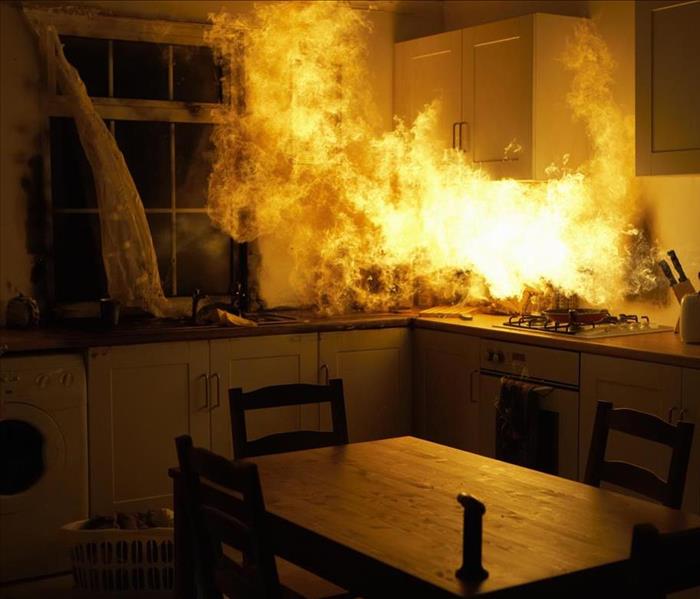 Our team of experts will restore your home to its original state. Call SERVPRO anytime at (973) 546-4977. We are always available.
Our team of experts will restore your home to its original state. Call SERVPRO anytime at (973) 546-4977. We are always available.
We Understand How Serious Fire Damage Is When It Comes To Your West Milford Home
One common way for a house fire to occur is by leaving a stove unattended. Cooking fires make up nearly 50% of all house fires in the US. Often the fire itself is quickly contained. However, hot smoke can billow out from the source of fire and leave behind unpleasant residues on upper walls, oven hoods, inside drawers, as well as on materials in the kitchen. Depending on the pressure in the fire, these residues may be challenging to remove by yourself, with many homeowners relying on professional restoration to get the job done.
The types of fire damage restoration you need for your West Milford home can be dependent on the type of fire that occurs. In our considerable experience, no two house fires are the same, which makes the restoration process more complicated. There's several things you need to be aware of when conducting smoke damage restoration. Using a one-size-fits-all approach can lead to further damage by spreading smoke around or inadvertently bonding it to surfaces.
Homeowners should be wary of using wet cleaning products on smoke residues as a first resource. The release of carbon in the form of smoke can lead to a dry residue on surfaces as well as walls and ceilings. The dry ash may not be physically bonded to the surface. However, by applying moisture directly onto dry ash, you may cause bonding on a molecular level. This bonding can make fire restoration tricky to manage. At SERVPRO, we recommend performing light vacuuming of all surfaces before introducing water. Vacuuming can remove dry soot from the surface, making the restoration more efficient.
Removal of dry soot with vacuuming is an effective, efficient first-step toward restoring your home to a preloss condition. However, it is likely that staining, as well as odor, remains behind after vacuuming. The type of smoke that kitchen fire releases can often be greasy from animal proteins. These areas require more technical knowledge to restore effectively. Often, spraying on oil-based solvents to the affected area using truck-mounted wands can help to dissolve greasy wet-smokes. SERVPRO recommends making use of soaking time to ensure that soils are correctly bonded to solvents before rinsing the affected walls.
Conducting fire restoration yourself can be tricky, and you risk causing further damage. Homeowners can contact SERVPRO of Wayne at (973) 546-4977 for a managed restoration.
Learn more about West Milford.
Seek Help from Experts to Handle Fire Damage in Your West Milford Residence.
1/15/2020 (Permalink)
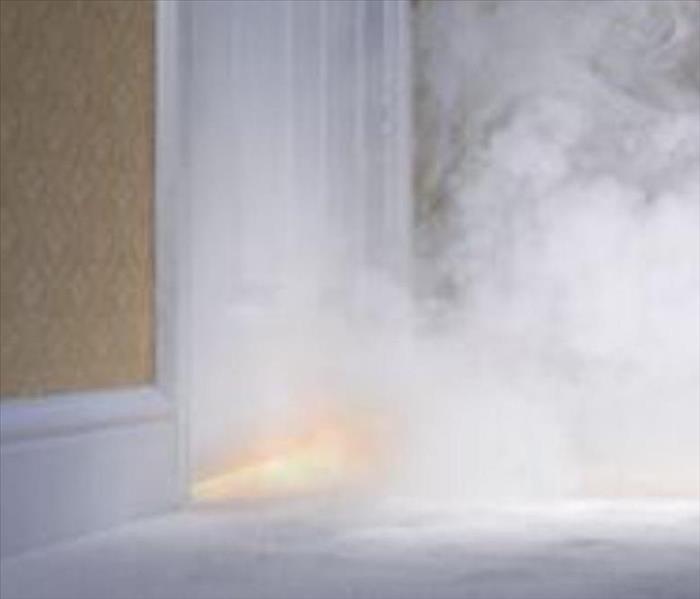 Call SERVPRO so we can quickly help to prevent additional destruction to your West Milford home after fire damage.
Call SERVPRO so we can quickly help to prevent additional destruction to your West Milford home after fire damage.
Let SERVPRO come in and take over your West Milford fire damage.
One of the worst losses homeowners can experience is losing their home and belongings to a fire. Fire and smoke can damage your possessions and jeopardize the structural integrity of your property. Since fire losses can be severe, it is advisable to start the remediation process quickly to prevent additional destruction to your home.
It is challenging to deal with fire damage in your West Milford residence because you might be distraught and unsure of where to begin. Trying to do the cleanup on your own can be overwhelming. You can hire a professional restoration company like SERVPRO to help you in completing the cleanup tasks. Our Fire & Smoke Damage Restoration Technicians (FSRTs) can help you to restore your home to its usual condition.
As you wait for our crew to arrive, you can do a few things, such as gathering items you may need to use in the coming week like clothes, school books, and toys, among others. Some of the things you should avoid doing include:
- Touching items with bare hands.
- Cleaning walls, carpets, and upholstery because this can cause more damage.
- Using electrical appliances before an electrician has examined them.
At SERVPRO, we understand how stressful it can be to deal with a fire loss incident. Therefore, we can work with you and your insurance firm to restore your home quickly. Apart from fixing the ruined property, we also seek to restore comfort and safety for our clients. Some steps we can take to restore your property include:
Understanding the type of fire
It is vital to understand the kind of fire that occurred to choose the right restoration strategy. We can consider if you are dealing with a kitchen, electrical or smoking-related fire, and the materials that burned. The materials which burned affect the aerosols and smoke particles a fire produces. Natural materials like paper, dry wood, natural fibers, and cork usually produce small, powdery, dry, non-smeary residues or dry smoke. Artificial materials like foam rubber, plastics, and similar polymers often produce large, wet, and easily smeared particles of residue or wet smoke.
Removing ruined items
We can remove things that present a safety hazard, such as burned furniture and charred building materials.
Deep cleaning
Our technicians can deep clean the salvageable materials to eliminate the smoke residues. We can also clean the walls, ceilings, and floors to remove stains.
Deodorizing your home
The smoke odors present in the affected areas may make it necessary to deodorize them so that your residence can be more habitable. Our crew can use odor counteracting beads, air scrubbers, or thermal foggers to eliminate the odors.
After a fire loss, SERVPRO of Wayne can help. We have the expertise required to deal with fire damage of any magnitude. Call us 24/7 at (973) 546-4977 for fast restoration of your Wayne, Pompton Lakes, or Ringwood home.
To find out more about West Milford, click here.
12 Protection Tips for Fire Damage Restoration
1/23/2019 (Permalink)
Source: https://www.randrmagonline.com
During a fire, innumerable toxic chemicals, poisonous gases, heavy metals, and other toxins are generated by the materials, household products, and vegetation that burns. These contaminants fill the air, become part of the ash, and are extremely dangerous to your health if inhaled or come in contact with your skin. We often forget about the dangers involved in the various environments we enter, but safety should always be a top priority.
If you are entering an area affected by fire or smoke, consider the following safety tips:
- Avoid breathing air contaminated by smoke odor and minimize your exposure to contaminated areas.
- If you need to enter a smoke damaged structure, wear proper personal protective equipment, including a proper fitting respirator with a P-100 HEPA filter designed to filter vapor or gasses (not a dust mask).
- Persons with heart or lung disease should consult their physician before using a mask during post-fire cleanup.
- Avoid handling or coming in direct skin contact with items or materials affected by smoke, soot, or ash. If you need to retrieve items damaged by smoke, wear proper personal protection equipment, such as coveralls, eye protection, gloves, proper foot wear, hardhat, etc.
- Avoid getting ash into the air as much as possible. Do not use leaf blowers or take other actions that will put ash into the air.
- Avoid using shop vacuums and other common vacuum cleaners. These do not filter out small particles, but blow them out the exhaust into the air where they can be inhaled.
- Do not allow children or pets to enter areas that have smoke odor, ash or soot. If children or pets get soot or ash on their skin or hair, wash immediately with mild soap and warm water.
- If you anticipate that you will need to be inside a building or area affected by smoke, attempt to ventilate the area by opening windows or doors unless doing so will allow outdoor smoke odor or ash to get in. Minimize your exposure as much as possible.
- Have an environmental testing laboratory test for Volatile Organic Compounds (VOC’s) and particulates to determine what types and concentrations of toxins may be present.
- When sorting through contents, don't take chances. People should not eat or drink anything that has signs of heat or smoke damage. When in doubt, throw it out!
- If you experience any adverse health symptoms from exposure to smoke or soot, seek medical attention immediately.
- If you need to be in an enclosed space that has smoke odor, such as an office, home, or building, try to set up air scrubbers with HEPA filters or other type of filter designed to remove ultra-fine particulate matter as quickly as possible. In addition, using a hydroxyl generator can help to break down odor causing molecules.
Contact us at 973-546-4977 if you have a service need or click here to visit our website to learn more about SERVPRO of Wayne's System Services.
Like Us on Facebook or Follow us on Twitter or Instagram and follow the tips, tricks and advice we share with our community.
Reduce Damage to Homes from Alternative Heating Sources
11/12/2018 (Permalink)
Source: https://disastersafety.org
Consumers often turn to alternative heating systems like wood pellet stoves (a.k.a. wood burning stove or wood pellet furnace) during the winter to heat their homes. If you’re considering switching to a wood pellet stove, space heater, or fireplace this winter, consider the following safety information.
Use Caution
- Before using any heating device, install carbon monoxide detectors in several parts of the house.
- Except where specifically recommended by the manufacturer, only the fuel (e.g., pellets, corn, log wood, coal or gas) for which a stove is designed should be used.
- Never use a kerosene heater indoors.
Stove Placement
Alternate heating stoves can vary in construction regarding self-contained insulation and thermal protection. A single layer iron-walled stove, for example, can generate enormous heat several feet in all directions. On the other hand, more sophisticated multiple walled insulated forced-air stoves can remain safe to the touch when in use.
Placement of the stove must take into consideration adequate space for installation, maintenance and replacement, flue or vent pipe routing, and most importantly, safe location relative to combustible materials. The National Fire Protection Association (NFPA) recognizes appropriate American National Standards Institute (ANSI) and Underwriters Laboratories (UL) standards and testing of the reduction of heat with distance from the unit as well as non-combustible shielding (defined in codes). Properly tested and rated stoves will have an attached safety label and an installation manual, which will detail the manufacturer’s recommended minimum separations. Some general guidelines are provided for different types of stoves in the following sections for cases when labels are missing.
In most cases, protection of the floor or combustible surface under a stove is required and specified including shielding beneath and extending on all sides in accordance with the code and label requirements. This includes adequate protection in front of the fire box and where ash removal is required.
Standards also exist for locating and routing flue and vent pipes in order to provide separation from combustibles adjacent to and through walls and to existing chimneys.
Pellet Stoves
These modern devices operate through an automated fuel-delivery process. In some designs, a fan delivers air to the fire and blows exhaust by-products out of a vent pipe that is smaller and typically less expensive than a chimney. Often, a separate fan blows air through heat exchangers in the stove and out into the home.
- Always hire an installer who is licensed and certified.
- Stove placement must allow for access to proper venting and electrical sources and must meet minimum required clearances. Certified installers operate according to these guidelines.
- Outlets must be checked for proper voltage, grounding and polarity.
- According to model building codes, multiple walled insulated forced-air stoves within compartments or alcoves should have a minimum of 3 inches of working space clearance along the sides, back and top with a total width of the enclosing space being at least 12 inches wider than the stove.
- Stoves having a firebox open to the atmosphere should have at least a 6-inch working space along the front combustion chamber side.
- Keep the stove clear of all combustible materials.
- Use PL vent pipes tested to UL 641.
The following materials should never be used to vent pellet appliances:
- Gas appliance Type B vent
- Single-wall stove pipe, unless approved by local codes and the installation manual.
- Inspect chimney before installation. Relining may be required.
- Altitudes higher than 2,500 feet may require special venting options.
- An outside air source may be required for houses with tight construction or strong kitchen, bath or other exhaust fans.
- Manufacturer’s instructions must be closely followed regarding sealing joints and seams, particularly of pressurized mechanical exhaust vents.
- Regular maintenance is critical to ensure safe operation.
- Frequency of cleaning will depend on the fuel type, grade and content.
- Components should be inspected daily.
- Professional cleaning is recommended for vent systems before each seasonal use.
Wood Stoves
These traditional heat sources remain popular, but have been linked to an increase in house and chimney fires.
- Choose a stove that has been tested by UL.
- Second-hand stoves should be free of broken parts or cracks.
- Maintain at least a 36-inch clearance between the stove and combustible materials or use fire-resistant materials to protect woodwork and other areas. Follow manufacturer’s guidelines.
- Keep the stove clear of combustible materials.
- Noncombustible floor covering should be used under and around the stove. The material should extend 18 inches on all sides.
- Prior to using the stove, place a layer of sand or firebrick in the bottom of the firebox.
- Vent pipes or chimneys must be inspected prior to use.
- Use 22- or 24-gauge metal with a total length of less than 10 feet.
- Maintain at least 18 inches between the top of the stove pipe and the ceiling or other combustible material.
- Ensure that the stove pipe enters the chimney at a spot higher than the outlet of the stove firebox and that it does not extend into the chimney flue lining.
- The inside thimble diameter should be the same size as the stove pipe for a proper seal.
- The stove pipe should not pass through a floor, closet or concealed space, or enter the chimney in the attic.
- If a metal chimney is used, make sure it is UL-approved.
Whether masonry or metal, the chimney should extend:
- At least 3 feet above the highest point where it passes through the roof, and
- At least 2 feet above any portion of the building within 10 horizontal feet of the chimney.
The chimney flue lining should not be blocked.
- Keep the chimney flue and stove pipe clean and free of obstructions.
Space Heaters
These appliances can be an affordable option for heating a small space, but they also are the leading source of house fires during winter months.
- Look for products that have been tested by UL.
- Buy a model with an automatic shut-off feature and heat element guards.
- Maintain a 36-inch clearance between the heater and combustible materials, such as bedding, furniture, wall coverings or other flammable items.
- Do not leave a heater unattended.
Electric heaters should be inspected prior to use.
- Check the cord for fraying and cracking, and look for broken wires or signs of overheating in the device itself.
- Use only heavy-duty extension cords marked with a No. 14-gauge or larger wire.
- If the heater’s plug has a grounding prong, use only a grounding (three-wire) extension cord.
- Never run the heater’s cord (or any cord) under rugs or carpeting.
Liquid-fueled heaters must be operated using only the fuel recommended by the manufacturer.
- Never use gasoline or any other substitute fuel.
- Allow the heater to cool down prior to refueling.
Fireplace
This popular heat source is found in homes throughout the United States, but requires proper maintenance and caution to ensure safe operation.
- Annual inspections are required by a professional chimney sweep.
- Regular cleaning will keep the fireplace free of obstructions and creosote.
- Have a removable cap installed at the top of the chimney to keep out debris and animals.
- Install a spark arrestor that has 1/4-inch mesh.
- Maintain proper clearance around the fireplace and keep it clear of combustible materials such as books, newspapers and furniture.
- Always close the screen when in use.
- Keep glass doors open during the fire.
- Approved fireplace tools are recommended.
- Never burn garbage, rolled newspapers, charcoal or plastic in the fireplace.
- Avoid using gasoline or any liquid accelerant.
- Clean out ashes from previous fires and store them in a noncombustible container with a tight-fitting lid. Keep the container outside and away from the house.
- Never leave a fire unattended.
- Make sure the fire is completely out before closing the damper.
Gas fireplaces require specific maintenance:
- Adjust the milli-volt output.
- Keep the glowing embers and logs clean.
- Inspect and clean the air circulation passages and fan.
- Clean the glass as needed.
- Avoid obstructing the vents.
Contact us at 973-546-4977 if you have a service need or click here to visit our website to learn more about SERVPRO of Wayne's System Services.
Like Us on Facebook or Follow us on Twitter or Instagram and follow the tips, tricks and advice we share with our community.
Put A Freeze on Winter Fires
11/3/2018 (Permalink)
Source: https://www.nfpa.org
Heating, holiday decorations, winter storms and candles all contribute to an increased risk of fire during the winter months. NFPA and the U.S. Fire Administration are teaming up to help reduce your risk to winter fires and other hazards, including carbon monoxide and electrical fires.
Heating
Heating is the second leading cause of U.S. home fires, deaths and injuries. December, January and February are the peak months for heating fires. Space heaters are the type of equipment most often involved in home heating equipment fires, figuring in two of every five fires (40%). More statistics on heating fires.
Carbon Monoxide
Often called the invisible killer, carbon monoxide (CO) is an odorless, colorless gas created when fuels such as gasoline, wood, coal, propane, etc. do not burn completely. In the home, heating and cooking equipment that burn fuel are potential sources of CO. Carbon monoxide incidents are more common during the winter months, and in residential properties. More statistics on carbon monoxide incidents.
Winter storms
Most of the U.S. is at risk for winter storms, which can cause dangerous and sometimes life-threatening conditions. Blinding wind-driven snow, extreme cold, icy road conditions, downed trees and power lines can all wreak havoc on our daily schedules. Home fires occur more in the winter than in any other season, and heating equipment is involved in one of every six reported home fires, and one in every five home fire deaths.
Generators
Portable generators are useful during power outages, however, many homeowners are unaware that the improper use of portable generators can be risky. The most common dangers associated with portable generators are carbon monoxide (CO) poisoning, electrical shock or electrocution, and fire hazards. According to a 2013 Consumer Product Safety Commission report, half of the generator-related deaths happened in the four coldest months of the year, November through February, and portable generators were involved in the majority of carbon monoxide deaths involving engine-driven tools.
Candles
December is the peak time of year for home candle fires; the top four days for home candle fires are New Year’s Day, Christmas, New Year’s Eve and Christmas Eve. Each year between 2009 and 2013, an average of 25 home candle fires were reported each day. More statistics on candle fires.
Electrical
Electrical home fires are a leading cause of home fires in the U.S. Roughly half of all home electrical fires involved electrical distribution or lighting equipment, while nearly another half involved other known types of equipment like washer or dryer fans, and portable or stationary space heaters. More statistics on electrical fires.
Christmas tree disposal
Christmas trees are combustible items that become increasing flammable as they continue to dry out in your home. Nearly 40 percent of home fires that begin with Christmas trees occur in January. Although Christmas tree fires are not common, when they do occur they’re much more likely to be serious. More statistics on Christmas tree fires.
Contact us at 973-546-4977 if you have a service need or click here to visit our website to learn more about SERVPRO of Wayne's System Services.
Like Us on Facebook or Follow us on Twitter, Google+, or Instagram and follow the tips, tricks and advice we share with our community.
College Campus Fire Safety
9/14/2018 (Permalink)
Source: https://www.nfpa.org/-/media/Files/Public-Education/Resources/Safety-tip-sheets/CampusSafetyTips.pdf
FACT
- Fires in dormitories are more common during the evening hours, between 5–11 pm, and on weekends.
- Roughly six out of seven fires in dormitories are started by cooking.
College students living away from home should take a few minutes to make sure they are living in a fire-safe environment. Educating students on what they can do to stay safe during the school year is important and often overlooked. College students living away from home should take a few minutes to make sure they are living in a fire-safe environment. Educating students on what they can do to stay safe during the school year is important and often overlooked.
SAFETY TIPS
- Look for fully sprinklered housing when choosing a dorm or off-campus housing.
- Make sure you can hear the building alarm system when you are in your dorm room.
- If you live in a dormitory, make sure your sleeping room has a smoke alarm, or your dormitory suite has a smoke alarm in each living area as well as the sleeping room. For the best protection, all smoke alarms in the dormitory suite should be interconnected so that when one sounds, they all sound.
- If you live in an apartment or house, make sure smoke alarms are installed in each sleeping room, outside every sleeping area, and on each level of the apartment unit or house. For the best protection, all smoke alarms in the apartment unit or house should be interconnected so that when one sounds, they all sound.
- Test all smoke alarms at least monthly.
- Never remove batteries or disable the alarm.
- Learn your building’s evacuation plan and practice all drills as if they were the real thing.
- If you live off campus, have a fire escape plan with two ways out of every room.
- When the smoke alarm or fire alarm sounds, get out of the building quickly and stay out.
- Stay in the kitchen when cooking.
- Cook only when you are alert, not sleepy or drowsy from medicine or alcohol.
- Check with your local fire department for any restrictions before using a barbeque grill, fire pit, or chimenea.
- Check your school’s rules before using electrical appliances in your room.
Smoking Sense
If you smoke, smoke outside and only where it is permitted, Use sturdy, deep, nontip ashtrays. Don’t smoke in bed or when you’ve been drinking or are drowsy.
Candle Care
Burn candles only if the school permits their use. A candle is an open flame and should be placed away from anything that can burn. Never leave a candle unattended. Blow it out when you leave the room or go to sleep.
Contact us at 973-546-4977 if you have a service need or click here to visit our website to learn more about SERVPRO of Wayne's System Services.
Like Us on Facebook or Follow us on Twitter, Google+, or Instagram and follow the tips, tricks and advice we share with our community.
Cleanup: What To Do Until Help Arrives
3/15/2018 (Permalink)
EMERGENCY TIPS FOR YOUR HOME SMOKE DAMAGE
Please follow these DOs and DON’Ts to help reduce damage and increase the chances of a successful restoration.
DO:
- Limit movement in the home to prevent soot particles from being embedded into upholstery and carpet.
- Keep hands clean. Soot on hands can further soil upholstery, walls and woodwork.
- Place dry, colorfast towels or old linens on rugs, upholstery and carpet traffic areas.
- If electricity is off, empty freezer and refrigerator completely and prop doors open to help prevent odor.
- Wipe soot from chrome on kitchen and bathroom faucets, trim and appliances, then protect these surfaces with a light coating of lubricant.
- If heat is off during winter, pour RV antifreeze in sinks, toilet bowls, holding tanks and tubs to avoid freezing pipes and fixtures.
- Wash both sides of leaves on house plants.
- Change HVAC filter, but leave system off until a trained professional can check the system.
- Tape double layers of cheesecloth over air registers to stop particles of soot from getting in or out of the HVAC system.
DON'T:
- Attempt to wash any walls or painted surfaces without first contacting SERVPRO of Wayne.
- Attempt to shampoo carpet or upholstered furniture without first consulting SERVPRO of Wayne.
- Attempt to clean any electrical appliances (TV sets, radios, etc.) that may have been close to fire, heat or water without first consulting an authorized repair service.
- Consume any food or beverages that may have been stored close to fire, heat or water. (They may be contaminated.)
- Turn on ceiling fixtures if ceiling is wet. Wiring may be wet or damaged and cause electrical shock, and air movement may create secondary damage.
- Send garments to the dry cleaner. Improper cleaning may set in smoke odor.
Contact us at 973-546-4977 if you have a service need or click here to visit our website to learn more about SERVPRO of Wayne's System Services.
Like Us on Facebook or Follow us on Twitter, Google+, or Instagram and follow the tips, tricks and advice we share with our community.
Smoke and Soot Damage Can Cause Pervasive Odors
3/1/2018 (Permalink)
Smoke and soot is very invasive and can penetrate various cavities within your home, causing hidden damage and odor. Our smoke damage expertise and experience allows us to inspect and accurately assess the extent of the damage to develop a comprehensive plan of action.
Smoke and soot facts:
- Hot smoke migrates to cooler areas and upper levels of a structure.
- Smoke flows around plumbing systems, seeping through the holes used by pipes to go from floor to floor.
- The type of smoke may greatly affect the restoration process.
Different Types of Smoke
There are two different types of smoke–wet and dry. As a result, there are different types of soot residue after a fire. Before restoration begins, SERVPRO of Wayne will test the soot to determine which type of smoke damage occurred. The cleaning procedures will then be based on the information identified during pretesting. Here is some additional information:
Wet Smoke – Plastic and Rubber
- Low heat, smoldering, pungent odor, sticky, smeary. Smoke webs are more difficult to clean.
Dry Smoke – Paper and Wood
- Fast burning, high temperatures, heat rises therefore smoke rises.
Protein Fire Residue – Produced by evaporation of material rather than from a fire
- Virtually invisible, discolors paints and varnishes, extreme pungent odor.
Our Fire Damage Restoration Services
Since each smoke and fire damage situation is a little different, each one requires a unique solution tailored for the specific conditions. We have the equipment, expertise, and experience to restore your fire and smoke damage. We will also treat your family with empathy and respect and your property with care.
Contact us at 973-546-4977 if you have a service need or click here to visit our website to learn more about SERVPRO of Wayne's System Services.
Like Us on Facebook or Follow us on Twitter, Google+, or Instagram and follow the tips, tricks and advice we share with our community.
Be Prepared
2/26/2018 (Permalink)
What You Can Do.
In order to be fully prepared, you should have all pertinent and proper information in a written plan for easy retrieval. Some key questions to consider when creating a personal emergency preparedness plan include:
- Do you have an escape or evacuation route in place?
- Do you have a designated meeting place in case of separation?
- Does everyone have a list of contact information including family members out of state who can serve as a point of contact?
- Do you have a disaster supply kit with necessary supplies?
- Do you have a first aid kit that includes necessary prescription medicines, over-the-counter medicines and basic medical supplies?
- Do you have enough non-perishable food and bottled water?
- Do you have access to important family documents, including insurance policies, bank, credit card and loan information and family records such as birth certificates and social security cards?
- Do you have an inventory of valuable household goods?
A well-equipped disaster supply kit should include, but is not limited to, the following:
- Water- a large enough supply to provide each person with 1 gallon daily for drinking and sanitation.
- Food- enough to last 3-7 days. Food needs to be non-perishable or canned food. You will also want to include a non-electric can opener, paper plates and plastic utensils.
- Bedding including sheets, blankets and pillows.
- Clothing- remember it may be warm, however, you may be working and cleaning and may prefer pants or long sleeves to protect your skin. You will also need sturdy, closed-toe, non-slip shoes if available.
- First aid kit including antiseptics or sanitizers and bandages, over-the-counter and prescription medications.
- Extra flashlights and batteries. Oil lanterns also provide a good source of light, if available.
- Toiletries including toilet paper and hygiene items. Hand sanitizers are also good to have on hand.
- Battery-operated radio with extra batteries so you can listen to weather service announcements.
- Cash- you will want some cash and small bills on hand as banks may not be open.
- Emergency phone numbers and contact information including insurance agent and family contacts.
- Tools, tarps, plastic sheets, trash bags, duct tape, etc. to help make minor repairs.
- Important documents should be kept in a waterproof bag or plastic sealed container and should include insurance, medical and family records, birth certificates, social security cards, bank account information and a complete home inventory analysis.
- Gas- fill your car’s tank ahead of time if time permits. You may also want to fill plastic gasoline-approved containers with gas to store.
- Pet care items including food, leash and a carrier or cage.
Don’t wait until it is too late; prepare now to help protect your family in an emergency or disaster situation.
Contact us at 973-546-4977 if you have a service need or click here to visit our website to learn more about SERVPRO of Wayne's System Services.
Like Us on Facebook or Follow us on Twitter, Google+, or Instagram and follow the tips, tricks and advice we share with our community.
KITCHEN CAUTIONS
11/14/2017 (Permalink)
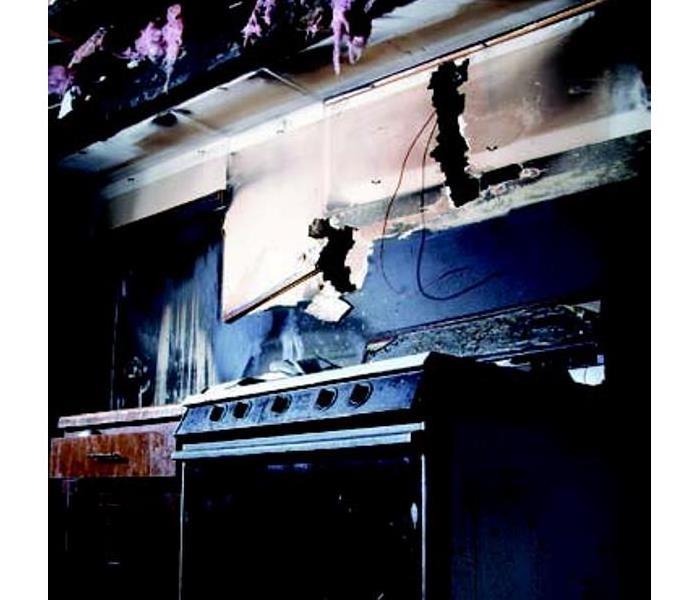 Fire Safety
Fire Safety
Thanksgiving is the peak day for home cooking fires, followed by Christmas Day and Christmas Eve. The leading cause? Unattended cooking.
Each November, families gather to celebrate Thanksgiving by preparing a delicious feast, but if you don’t practice safe cooking habits, your holiday could become hazardous very quickly. According to the National Fire Protection Association, cooking fires are the number one cause of home fires and home injuries. The leading cause of fires in the kitchen is unattended cooking. It’s important to be alert to prevent cooking fires.
- Be on alert! If you are sleepy or have consumed alcohol don’t use the stove or stovetop.
- Stay in the kitchen while you are frying, grilling, boiling, or broiling food.
- If you are simmering, baking, or roasting food, check it regularly, remain in the kitchen while food is cooking, and use a timer to remind you that you are cooking.
- Keep anything that can catch fire—oven mitts, wooden utensils, food packaging, towels, or curtains—away from the stovetop.
If you have a cooking fire, consider the following safety protocols to help keep you and your family safe.
- Just get out! When you leave, close the door behind you to help contain the fire.
- Call 9-1-1 or the local emergency number after you leave.
- For an oven fire, turn off the heat and keep the door closed.
- If you try to fight the fire, be sure others are getting out and you have a clear way out.
- Keep a lid nearby when you’re cooking to smother small grease fires. Smother the fire by sliding the lid over the pan and turn off the stovetop. Leave the pan covered until it is completely cooled.
Contact us at 973-546-4977 if you have a service need or click here to visit our website to learn more about SERVPRO of Wayne's System Services.
Like Us on Facebook or Follow us on Twitter, Google+, or Instagram and follow the tips, tricks and advice we share with our community.
How To: Use a Fireplace
11/3/2017 (Permalink)
 Fireplace safety
Fireplace safety
Add ambience and save on heating costs by utilizing your fireplace this winter. Here's all you need to know about the proper technique and safety precautions.
By Katelin Hill
Source: https://www.bobvila.com/
During the colder months, nothing beats warming the house with a crackling fire. But while wood-burning fireplaces should give you long-lasting and evenly burning flames, one simple mistake can fill your living room with smoke—or even spark a dangerous house fire. Here’s the proper technique for how to use a fireplace, with safety precautions every homeowner should know.
MATERIALS AND TOOLS Available on Amazon
– Smoke detector
– Carbon monoxide detector
– Batteries
– Fire extinguisher
– Flashlight (optional)
– Hardwood or softwood kindling
– Newspaper (optional)
– Matches
– Fireplace gloves
– Metal fireplace poker
– Metal fireplace shovel
– Metal box for fireplace ashes
STEP 1: Stay Safe
Before bringing out the lighter, it’s vital to understand safety precautions for using a fireplace. First, always double-check that your fire extinguisher, smoke detector, and carbon monoxide detector are each in working order (check those batteries!). Remove anything flammable within three feet of the fireplace in case stray sparks escape the hearth, and use a fireplace screen as well. Make sure the flue isn’t blocked by obstructions like an animal’s nest, especially if this is your first time using the fireplace. If the system hasn’t been recently inspected, hire a chimney sweep certified by the Chimney Safety Institute of America(CSIA) to do the job.
STEP 2: Gather the Kindling
Gather kindling in a variety of sizes (small, medium, and large) for the proper fire-building technique that is outlined below. To emit less smoke and soot, make sure the wood is dry, well-seasoned, and split a minimum of six months ago. You can choose either hardwood or softwood for the fire; while hardwoods like oak or maple burn longer and create more sustained heat, softwoods like cedar or pine start fires easier because they ignite quickly. Whatever you don’t use can return to the firewood rack, best stored outdoors in an elevated and covered location.
Note: Never burn trash, plastic, painted materials, or anything with chemical treatment like scraps of pressure-treated wood—these materials can release harmful chemicals into your home.
STEP 3: Open the Damper
The damper is a movable plate inside the flue. When opened, it allows the smoke and ash to travel safely up the chimney. If you start a fire with a closed damper, however, the smoke will have no escape route and circle back into the house.
Adjust the damper as needed with the handle located inside of the chimney. It will move either front to back, left to right, or in a clockwise or counterclockwise rotation. Check to make sure you opened it properly by sticking your head in the flue and looking upwards, using a flashlight if necessary. You should see up the flue without any obstructions if the damper is open; a closed damper will block your view entirely.
STEP 4: Prime the Flue
Now, gauge the temperature. If you feel a rush of cold air (which usually occurs if the chimney is built on the outside of the house), then you need to prime the flue—in order words, you need to preheat it. Otherwise, the cold draft may cause smoke to blow into the room. Light a roll of newspaper and hold it against the open damper to send warm air into the flue. The draft should reverse after a few minutes, making your fireplace ready for action.
STEP 5: Build the Fire
While there are multiple ways to build a fire, the CSIA recommends the top-down method, which produces less smoke and requires less tending. Start by donning thick fireplace gloves and grabbing a metal poker. Position large pieces of wood in the bottom of the fireplace in one row, perpendicular to the opening of the fireplace. Next, take mid-sized pieces of wood, and stack four or five rows on top of the base layer in alternating directions. Make sure the stack takes up no more than half the height of your fireplace. Now add your smallest pieces of wood, making sure these pieces are very dry. The tiniest bits (which can take the form of wood shavings or bunched-up newspapers) should be at the very top.
Light the top of the stack with a single match. The fire should travel down, igniting the pieces underneath without prompting. Let the fire burn for as long as you’d like. Don’t close the damper until the fire is completely out and all the embers have stopped burning.
STEP 6: Clean the Ashes
The CSIA says you can leave a bed of ashes between one to two inches in the fireplace as an insulating layer, which helps the next fire to burn. But when you need to dispose of ashes, proceed with caution. Coals may take several hours or several days to completely cool, and ash could still be burning during that time. Using a metal shovel, scoop ashes into a metal container with a tight-fitting lid. Store the container outdoors away from the house, and not in garages or on decks.
Contact us at 973-546-4977 if you have a service need or click here to visit our website to learn more about SERVPRO of Wayne's System Services.
Like Us on Facebook or Follow us on Twitter, Google+, or Instagram and follow the tips, tricks and advice we share with our community.
What To Do After a Fire
9/28/2017 (Permalink)
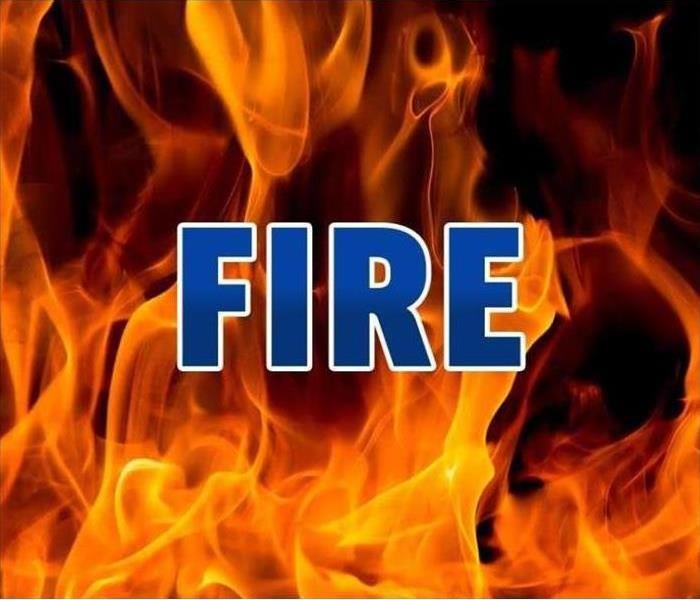 Fire Damage
Fire Damage
Now that the fire is out, there are a few things you need to know. Here is a check list to follow:
Step 1 - Securing the site
- Protect the fire site from any further damage by weather, theft or vandalism. Do not leave the site unsecured.
- If you are the owner it is your responsibility to see that openings are covered against rain and entry. Make sure outside doors to the property can be locked and secured. The Fire Department will help secure the premises until responsibility can be handed over to the tenant or insurance company.
- If you are the tenant, contact your real estate agent or landlord and inform them of the fire. If you cannot contact them and you need professional assistance in boarding the premises, a general contractor for or fire damage restoration firm can help. Check your telephone directory.
- If you plan to leave the site, try to remove any valuable remaining in the building.
- Contact your own insurance agent to report the loss.
Step 2- Cautions
- Household wiring which may have been water damaged should be checked by a licensed electrician before power is turned back on.
- Check for structural damage caused by the fire. Roofs and floors may be weakened. The local Municipality's Building Inspector may be able to help.
- Food, drink and medicines exposed to heat, smoke or soot may be discarded in the appropriate manner.
- Refrigerators and freezers left unopened will hold their temperature for a short time. However do not attempt to refreeze thawed items.
- The Fire Department will call for the services of the local gas, fuel and electricity suppliers to disconnect services before they leave the site.
- If a utility (gas, electricity or water) is disconnected, it is your responsibility to have the services checked and reconnected by a licensed trade person. Do not attempt to reconnect the service yourself.
- Start collecting receipts for any money you spend. These are important because you can use them to show the insurance company what money you have spent relating to your fire loss and also verifying losses claimed.
Step 3 - Insurance Claims
- Make personal contact with the insurance claims manager.
- Advise the claims manager of loss or damage and give him, or her, a forwarding address and telephone number if the circumstances have forced you to leave the damaged fire building.
- The sooner the insurance company is alerted, the quicker the insurance claim can be processed, as the company has to alert the insurance adjuster to carry out the inspection.
- Try to form an inventory, as soon as possible, of household items either inside or outside the buildings which have been damaged by fire. The inventory of damaged items will further speed the claim when the loss assessor makes contact. Do not throw away any damaged goods until after the inventory is made by the insurance adjuster.
Step 4 - Leaving your home
- If you have to leave your home because the fire has left it unsafe, contact the local police. They may be able to keep an eye on the property in your absence.
- Check with your insurance company to find out whether you are entitled to stay in hotel as part of a temporary housing clause in your policy, or how soon you might get an advance on your eventual insurance claim settlement.
- Provided it is safe to do so, try to locate the following to take with you:
- Identification
- Vital medicines, such as blood pressure regulating drugs or insulin.
- Eyeglasses, hearing aids, prosthetic devices or personal aids.
- Valuables such as credit cards, check-books, insurance policies, savings account books, money and jewelry.
Notify these people of your new address
- Your employer.
- Family and friends.
- Your children's schools.
- Your Post Office. Have them either hold or forward your mail, depending on the length of time you expect to be relocated.
- Delivery services like newspapers.
- Telephone company and the suppliers of gas, electricity and water.
When fire or water damage strikes, you need professional help to get your property back to preloss condition. SERVPRO of Wayne provides 24-hour emergency service and is dedicated to being faster to any size disaster. Our highly trained technicians can respond immediately to your residential or commercial emergency.??
Contact us at 973-546-4977 if you have a service need or click here to visit our website to learn more about SERVPRO of Wayne's System Services.
Like Us on Facebook or Follow us on Twitter, Google+, or Instagram and follow the tips, tricks and advice we share with our community.
Fire Damage: Escape Planning
3/17/2017 (Permalink)
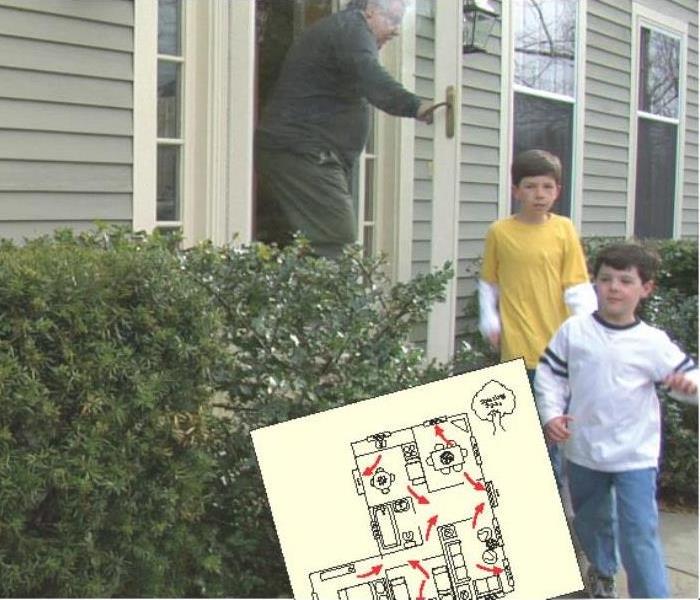 Fire Escape Planning
Fire Escape Planning
Plan Ahead! If a fire breaks out in your home, you may have only a few minutes to get out safely once the smoke alarm sounds. Everyone needs to know what to do and where to go if there is a fire.
Facts
- A closed door may slow the spread of smoke, heat, and fire. Install smoke alarms inside every sleeping room and outside each separate sleeping area. Install alarms on every level of the home. Smoke alarms should be interconnected. When one smoke alarm sounds, they all sound.
- According to an NFPA survey, only one of every three American households have actually developed and practiced a home fire escape plan.
- While 71% of Americans have an escape plan in case of a fire, only 47% of those have practiced it.
- One-third of American households who made an estimate thought they would have at least 6 minutes before a fire in their home would become life-threatening. The time available is often less. And only 8% said their first thought on hearing a smoke alarm would be to get out!
Safety Tips
- MAKE a home escape plan. Draw a map of your home showing all doors and windows. Discuss the plan with everyone in your home.
- KNOW at least two ways out of every room, if possible. Make sure all doors and windows leading outside easily open.
- HAVE an outside meeting place (like a tree, light pole or mailbox) a safe distance from the home where everyone should meet.
- PRACTICE your home fire drill at night and during the day with everyone in your home, twice a year.
- PRACTICE different ways out.
- TEACH children how to escape on their own in case you can't help them.
- CLOSE doors behind you as you leave.
IF THE ALARM SOUNDS....
- If the smoke alarm sounds, GET OUT AND STAY OUT. Never go back inside for people or pets.
- If you have to escape through smoke, GET LOW AND GO under the smoke to your way out.
- CALL the fire department from outside your home.
Information provided by the National Fire Protection Association (nfpa.org).
Contact us at 973-546-4977 if you have a service need or click here to visit our website to learn more about SERVPRO of Wayne's System Services.
Like Us on Facebook or Follow us on Twitter or Instagram and follow the tips, tricks and advice we share with our community.
Fire Damage: Home Heating System Safety
3/10/2017 (Permalink)
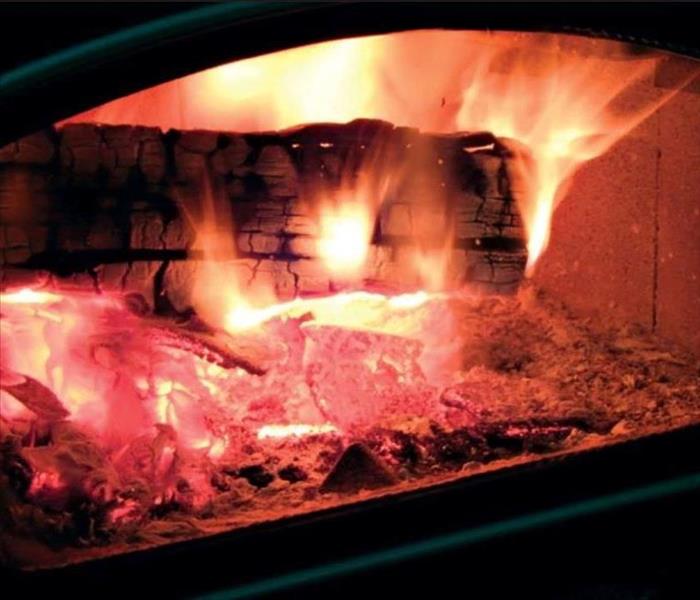 fireplace safety, fire safety
fireplace safety, fire safety
As the temperature drops outside, wood and pellet stoves may be fired up inside the home. What you may not realize is that heating equipment is one of the leading causes of home fires during the winter months.
Did you know that heating equipment is one of the leading causes of home fire deaths? With a few simple safety tips and precautions you can prevent most heating fires from happening.
Wood and Pellet Stove Safety
- Have a QUALIFIED professional install stoves, chimney connectors, and chimneys.
- Stoves should be listed by a qualified testing laboratory.
- In wood stoves, burn only DRY, seasoned wood. In pellet stoves, burn only dry, seasoned wood pellets.
- Have your chimney and stove INSPECTED and cleaned by a certified chimney sweep every fall just before heating season.
- CLEAN the inside of your stove periodically using a wire brush.
- Allow ashes to COOL before disposing of them. Place ashes in a covered metal container. Keep the container at least 10 feet away from the home and other buildings.
- Keep a CLOSE EYE on children whenever a wood or pellet stove is being used. Remind them to stay at least 3 feet away from the stove.
- Stoves need SPACE. Keep anything that can burn at least 3 feet away from the stove.
- INSTALL and maintain carbon monoxide alarms (CO) outside each sleeping area and on every level of the home. For the best protection, interconnect the CO alarms. When one sounds, they all sound.
Other Heating System Safety Tips
- Keep anything that can burn at least three-feet away from heating equipment, like the furnace, fireplace, wood stove, or portable space heater.
- Have a three-foot “kid-free zone” around open fires and space heaters.
- Never use your oven to heat your home.
- Have a qualified professional install stationary space heating equipment, water heaters or central heating equipment according to the local codes and manufacturer’s instructions.
- Have heating equipment and chimneys cleaned and inspected every year by a qualified professional.
- Remember to turn portable heaters off when leaving the room or going to bed.
- Always use the right kind of fuel, specified by the manufacturer, for fuel burning space heaters.
- Make sure the fireplace has a sturdy screen to stop sparks from flying into the room. Ashes should be cool before putting them in a metal container. Keep the container a safe distance away from your home.
- Test smoke alarms at least once a month.
For more information on fire safety, visit the National Fire Protection Association's (nfpa.org) website.
Contact us at 973-546-4977 if you have a service need or click here to visit our website to learn more about SERVPRO of Wayne's System Services.
Like Us on Facebook or Follow us on Twitter or Instagram and follow the tips, tricks and advice we share with our community.
Fire Damage: Portable Fire Extinguishers
2/27/2017 (Permalink)
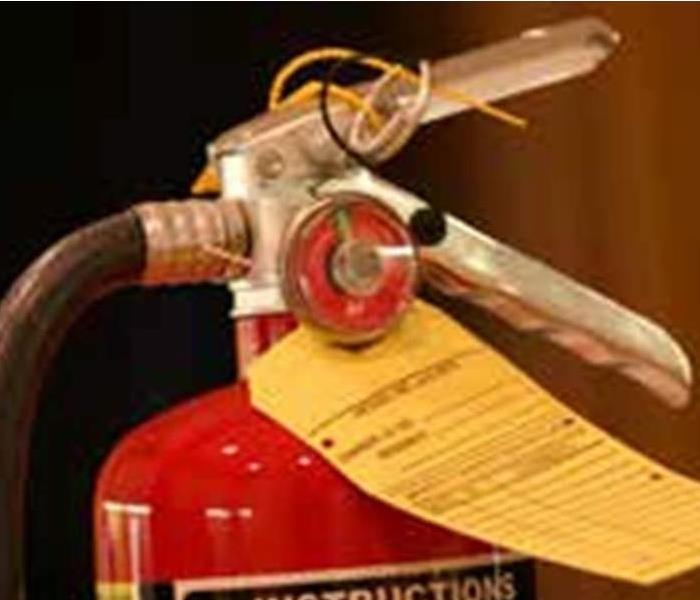 fire safety, fire extinguisher, extinguishing a fire, fire
fire safety, fire extinguisher, extinguishing a fire, fire
Portable fire extinguishers can be life and property saving tools when used correctly. In order to operate an extinguisher, the National Fire Protection Association (NFPA) suggests remembering the word PASS:
- Pull the pin. Hold the nozzle pointing away from you and release the locking mechanism.
- Aim low. Point the extinguisher at the base of the fire.
- Squeeze the lever slowly and evenly.
- Sweep the nozzle from side-to-side.
Read the instructions on the fire extinguisher and become familiar with them before a fire breaks out.
Remember, extinguishers do have limitations. It is also important to ensure you have the correct type of extinguisher for your facility.
To find more information on choosing the appropriate class of extinguisher, please visit the NFPA website at nfpa.org.
Contact us at 973-546-4977 if you have a service need or click here to visit our website to learn more about SERVPRO of Wayne's System Services.
Like Us on Facebook or Follow us on Twitter or Instagram and follow the tips, tricks and advice we share with our community.
Fire Damage: Smoke Alarms - LIFE SAVERS
2/27/2017 (Permalink)
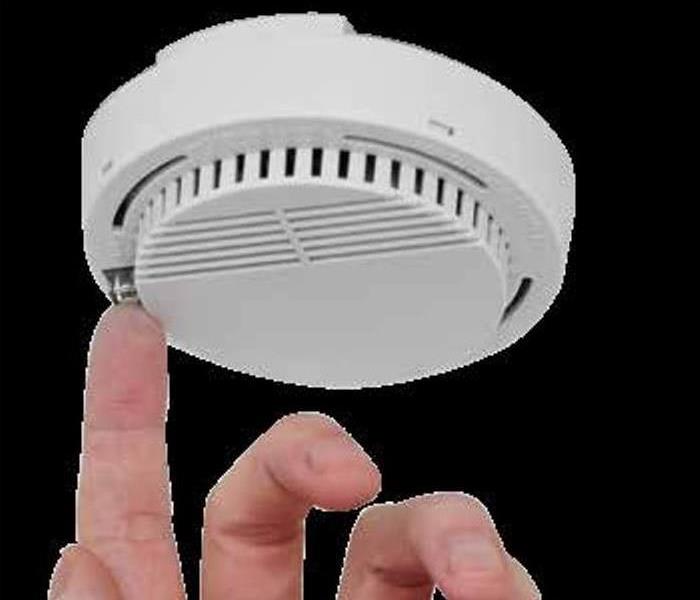 smoke detector, smoke alarm, fire safety
smoke detector, smoke alarm, fire safety
FIRE FACTS:
- 7 people die every day from a home fire.
- 36 people suffer injuries as a result of home fires every day.
- $7 billion in property damage occurs each year.
Smoke alarms save lives when properly installed and maintained, according to the National Fire Protection Association (NFPA).
In homes, smoke alarms should be in every bedroom and on every level, including the basement. In office and commercial environments, check your state requirements or contact your local Fire Marshall to help ensure all
codes are met.
Test smoke alarms monthly using the test button. Smoke alarms with non-replaceable batteries need the entire smoke alarm unit replaced every ten years. Other alarms need batteries replaced every year, and the unit replaced every ten years. If the alarm chirps signaling low battery, take the proper steps to replace the unit or the batteries immediately. Never disable or remove the battery from an alarm. Almost half of fires where smoke alarms were present but did not activate had
missing or disconnected batteries (NFPA).
In larger commercial facilities, hard wired or wireless smoke alarms offer benefits such as not needing to be tested as often and activating throughout the entire building if smoke is detected in just one area (NFPA).
If you need help installing, testing or changing batteries in your smoke alarms, contact your local fire department, an electrician or the American Red Cross.
Be sure your home or workplace has a fire emergency plan in place and conduct regular fire
drills. For more information on Emergency Preparedness, contact SERVPRO of Northern Sussex County.
Contact us at 973-546-4977 if you have a service need or click here to visit our website to learn more about SERVPRO of Wayne's System Services.
Like Us on Facebook or Follow us on Twitter or Instagram and follow the tips, tricks and advice we share with our community.
Fire Damage: The Public Adjuster
2/10/2017 (Permalink)
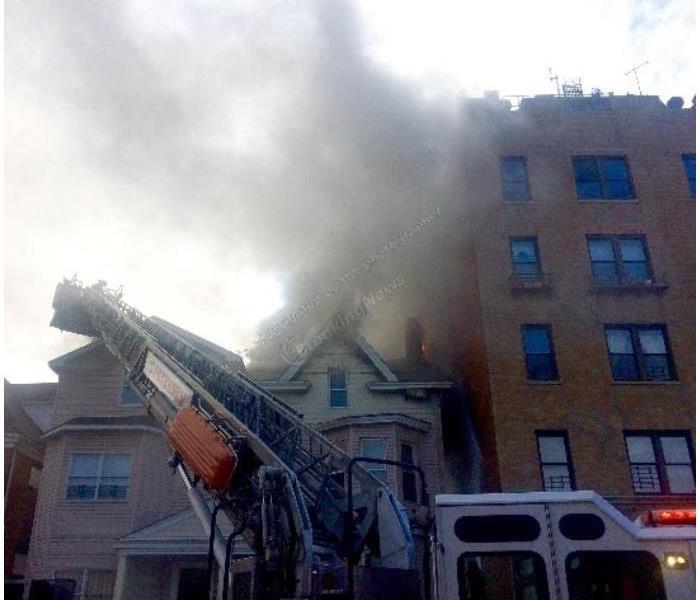 House Fire
House Fire
If you have ever filed an insurance claim, whether it be for your home, auto or health, you know it can be a very stressful process fraught with uncertainty and questions. Will I be covered? How much will I be covered for? How will it impact my premiums?
Because of this confusion and uncertainty, many turn towards a Public Adjuster to get them through their ordeal. But, before engaging a Public Adjuster, there are a few things you need to be aware of.
What happens first?
After you’ve taken care of your loved ones, you will need to get your home back in order. When you have a damaging event to your home, for which you wish to submit a claim, one of the first things you should do is to contact your agent or your insurance company directly.
Your insurance company will record your loss and issue you a claim number. They will also assign an internal or independent adjuster to review your claim. This adjuster works on behalf of the insurance company. This adjuster will schedule a visit to your home to inspect and assess the loss to determine coverage. This is a benefit to you as a policyholder and does not cost you anything.
Once coverage is determined, the insurance company’s adjuster will then discuss actions which need to be taken immediately, such as getting the home dried out or possibly boarded up if needed. They’ll then provide you with their assessed value of the loss.
So now comes the question of whether or not to use a Public Adjuster. Let’s go through this.
First, exactly what is a public adjuster?
A public adjuster is someone that you pay to help you with your insurance claim. They are an insurance claims specialist who interprets the homeowner's policy, assesses the damage and how much it will cost to repair, and negotiates with the insurance company on behalf of the homeowner until the claim is settled.
The Public Adjuster does not represent your insurance company nor is he/she assigned by your insurance company. Public Adjusters are sought and hired by you to be your representative and deal with your insurance company. For their services they will charge you a fee, typically a percentage of the total award amount that they negotiate with your insurance company.
Remember, a Public Adjuster can assist with the claims process, but cannot get you more money than you are entitled to under your insurance policy and will not be able to get your claim settled any faster. You are simply paying them for a service.
OK, so when should I use a Public Adjuster?
Many will hire a Public Adjuster simply because they don’t have the time to deal with the claim. Remember, though, you are paying a fee for this convenience.
Typically, the Public Adjuster will charge a fee of 10%-15% of the final claim awarded. This can be a sizable fee, so be sure before you sign any paperwork. It’s also important to know that this fee can be negotiated depending on the size of the loss.
If you chose to deal with the claim personally, there are steps you can take before bringing a Public Adjuster in. Your insurance company is a reputable business and they want you to continue to be a policyholder.
If you feel you can justify additional damages, speak with your insurance company’s assigned adjuster and present your case. If you are not getting anywhere, ask to speak with a more senior representative. You may find that these steps yield good results.
If you still feel that you need more representation, this is when you may consider working with a Public Adjuster. It’s really a judgment call as to whether or not you believe your loss, and the associated damages you claim, are fairly reflected in your insurance company’s assessment.
Before you proceed, do some simple math.
Let’s say you had a fire loss, for which your insurance company has assessed a $200,000 payment to cover the loss, but you feel you are entitled to $20,000 more and you have not been successful with your discussions with your adjuster. So, you hire a Public Adjuster with a fee of 10%. At the end of it, he argues and wins $10,000 more from your insurance company for a total payment of $210,000. The fee will be $21,000 to the Public Adjuster, netting you $189,000. You would have been better off accepting the initial payment offered by the insurance company.
How can I find a good Public Adjuster?
As with anything else, a Public Adjuster can be found by doing some internet searches. Another place to start would be going to the NAPIA website. They have a vetting process and require their members to be licensed and to have been in business for at least 2 years.
Some steps you should think about:
- Always avoid any Public Adjuster who tries to pressure you into signing a contract. Remember this a business transaction.
- Interview several.
- Get reference lists and check with their prior clients.
- Check their company websites.
- You can also ask friends and colleagues who they might recommend.
- Avoid single practitioners or small firms unless they demonstrate a good track record.
Before signing anything, make sure your rights are protected:
- Determine how long you have to cancel any contract you sign. New Jersey protects consumers with a 72-hour cancellation provision under the Consumer Fraud Act.
- Verify that the Public Adjuster will remove any lien once the contract is terminated.
- Limit the contract to no more than six months.
Once you’ve identified your Public Adjuster, you will sign a contract between you and them, which obligates your relationship with them until the claim is settled. The Public Adjuster will likely place a lien on your insurance claim, naming them as additional payee on all payments from your insurance company.
What role with the Public Adjuster play in the process?
So now you’ve hired a Public Adjuster. Here’s what you can count on him doing and what you should not expect.
You will still be very involved in helping the Public Adjuster document the loss. He will need details of the event and information about content damage and their value.
A public adjuster will assess your losses and help you get every penny you deserve, but don't expect miracles. Understand the insurance company may not agree to everything you want just because you hired a public adjuster.
The Public Adjuster will be your representative and negotiate every aspect of the loss with your insurance company until a final agreement is made. Once the negotiations are completed, your Public Adjuster’s job is done. They do not perform or manage the restoration portion of this project.
The next and final step is to begin the restoration process by hiring the various contractors needed to perform the cleaning and repairing of your home. This could start during negotiations between your Public Adjuster and your insurance company, depending on the urgency and what may have been agreed to.
Remember, the Public Adjuster may provide you contractor referrals to do the work, however, you are under no obligation to use them, after all, this is your home and you have every right to decide who performs the work.
Always consider using SERVPRO of Wayne for your cleaning and restoration needs, regardless of any contractors your Public Adjuster may insist on using. SERVPRO of Wayne is a full service restoration company, providing everything from board-up and drying, to cleaning and rebuilding.
Summary
I hope this has helped you in understanding the role and costs surrounding using a Public Adjuster. There is always risk in any decision. Minimize your risk by doing your research first by working with your insurance company. It will be well worth it to go down this path first.
Always feel free to contact SERVPRO of Wayne at 973-546-4977 to discuss this before making your decision. We’re always glad to help.
Like Us on Facebook or Follow us on Twitter or Instagram and follow the tips, tricks and advice we share with our community.
Fire Damage: HALT WINTER HEATING HAZARDS
1/13/2017 (Permalink)
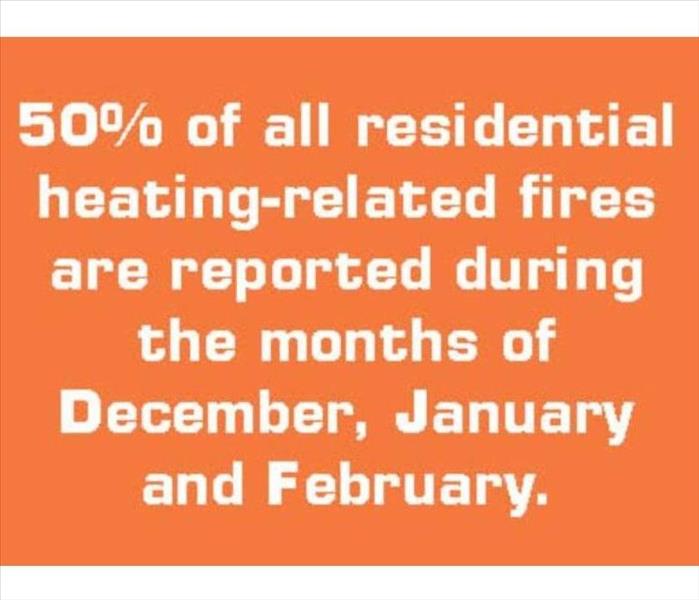 Heating Fire Damage Statistics
Heating Fire Damage Statistics
The winter season is here and with it comes shorter days and lower temperatures. No matter where you live, winter brings a change in the weather. In an effort to keep our homes and workplaces cozy, many people use alternative heat sources like fireplaces, portable space heaters, and wood burning stoves. Did you know, heating equipment is a leading cause of home fire deaths? According to the National Fire Protection Association, heating equipment fires cause an estimated $1 billion in direct property damage annually. Keep the following safety tips in mind to help reduce your risk of a heating-related fire.
- Keep anything flammable at least three feet away from heating equipment, like the furnace, fireplace, wood stove, or a portable space heater. Have a three foot “kid-free zone” around open fires and space heaters.
- Make sure the fireplace has a sturdy screen to stop sparks from flying into the room. Ashes should be cool before putting them in a metal container. Keep the container a safe distance away from your home.
- Remember to turn portable heaters off when leaving the room or going to bed.
- Always use the right kind of fuel, specified by the manufacturer, for fuel burning space heaters.
- Have heating equipment and chimneys cleaned and inspected every year by a qualified professional.
- Have a qualified professional install stationary space heating equipment, water heaters or central heating equipment according to the local codes and manufacturer’s instructions.
- Test smoke alarms monthly.
If your property does suffer fire damage, contact SERVPRO® of Wayne to help make it “Like it never even happened.”
Call us today at 973-546-4977 and be sure to check us out on Facebook and Twitter for tips on how to protect you
Fire Damage: Helping Homeowners Recover
12/16/2016 (Permalink)
 SERVPRO professionals cleaning a fire damage home.
SERVPRO professionals cleaning a fire damage home.
A back-draft of emotions often sweeps over the homeowners after a fire ravages a home. Fear, uncertainty, stress and doubt about the future of the property can overwhelm the homeowner long after the flames have been extinguished and the smoke has cleared.
So after the first wave of heroes have rescued the property, let SERVPRO® of Wayne help you restore it. With the industry approved training to employ rapid response, the utmost professionalism, cutting-edge technology and open communication, we strive to restore not only the home, but the customer’s peace of mind, as well.
So, before you risk doing further damage by attempting to clean up the damage yourself, call the fire damage cleanup and restoration professionals.
What You Can Do Until Help Arrives
- Limit movement in the home to prevent soot particles from spreading and additional damage from occurring.
- Place clean towels or old linens on rugs and high traffic areas and upholstery.
- Coat chrome faucets, trim and appliances with petroleum jelly or oil.
- Place aluminum foil or wood blocks between furniture legs and wet carpet.
- Do not wash any walls or painted surfaces.
- Do not shampoo carpet or upholstery.
- Do not clean any electrical equipment.
- Do not send clothing to a dry cleaner since improper cleaning may set smoke odor.
SERVPRO® of Wayne provides the following restoration services:
- Board-ups-In some cases it may be important to secure openings to your home or structure using sturdy, durable materials designed to protect it from both weather intrusion and intrusion by outsiders. SERVPRO® may perform the board-up themselves, or outside subcontractors may be utilized.
- Move-Outs - If prolonged exposure to the loss event could cause additional damage to your contents, your contractor requests relocation of the contents, or the safety of your contents is a concern,a move-out may be recommended. In these situations, SERVPRO® is trained to properly inventory, move out and control the contents from the structure during the cleaning, restoration and deodorization process.
- Electronics Cleaning - Smoke residues can contain acids that corrode metal surfaces when moisture is also present. If the residues are not removed, corrosion can eat away at the metal casing and can ultimately cause electronic failure in the device. SERVPRO® can clean the outside casing correctly, as well as refer your equipment to a qualified electronics vendor.
- Artwork - Artwork ranges from inexpensive framed pictures to extremely valuable fine art. Restoration of valuable art requires the use of a trained art restorer (known as a conservator), while less expensive art may not warrant these costly specialized services. SERVPRO® will usually subcontract fine art restoration to a conservator. If desired, SERVPRO® may attempt to remove smoke residues and odors, after qualifying with the customer that such cleaning procedures may affect the visible appearance of the item.
- Structural Cleaning - After a smoke or fire damage, ceilings, walls, woodwork, carpeting and floors will often need a thorough cleaning. SERVPRO® will pretest to determine the extent of damage, and then use the specific equipment and cleaning products required to clean and protect the different types of surfaces found in your structure. Depending on the amount of soot, SERVPRO® may even be able to reduce the cost of recovery by cleaning lighter soot deposits found on some surfaces, eliminating the expense incurred with repainting or refinishing. In other cases, SERVPRO® will clean to “prepare for painting”. This process deodorizes and ensures the new paint will adhere properly to the surface.
- Contents Cleaning–All of the restorable contents in affected areas will be professionally cleaned and deodorized. This includes area rugs, furniture, draperies and upholstery. SERVPRO® begins by carefully inspecting and testing all fabrics in the structure to determine which cleaning methods are most appropriate. SERVPRO® can provide wet or dry cleaning services. Additionally, all the other restorable contents will be cleaned and deodorized to pre-loss condition. This includes electronics, art, wood furniture, kitchen items,clothing, bedding, bric-a-brac and much more. Finally,SERVPRO® can provide an inventory list of all “to be claimed” items if requested.
- Deodorization–SERVPRO® provides specialized services that rid your home or place of business of offensive odors left by fire or smoke damage. SERVPRO® does not merely cover up lingering odors with a fragrance, they seek out the sources of the odor and remove them.
- Repair / Rebuild-In most cases, SERVPRO® can provide full scope repair and rebuild services, including structural repairs, painting and flooring.
So, before you risk doing further damage by attempting to clean up the damage yourself, call the fire damage cleanup and restoration professionals at 973-546-4977.
Contact us at 973-546-4977 if you have a service need or click here to visit our website to learn more about SERVPRO of Wayne's System Services.
Like US on Facebook and follow the tips, tricks and advice we share with our community.
Fire Safety - Celebrate Safely This Holiday Season
12/1/2016 (Permalink)
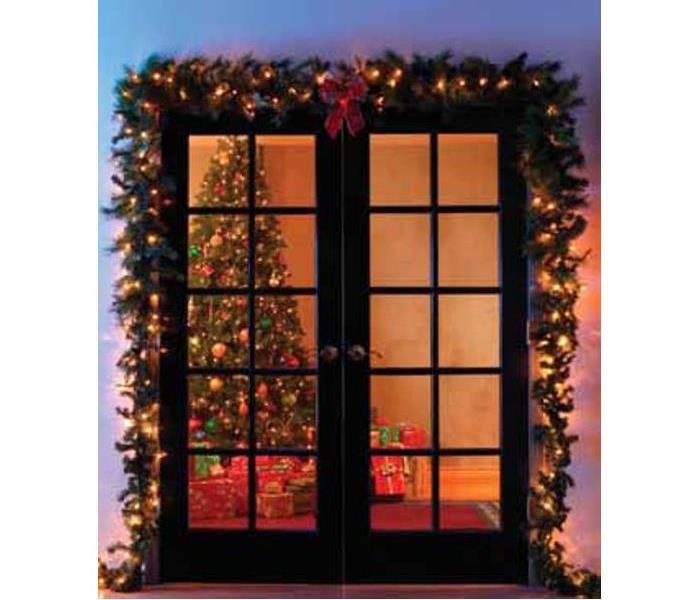 Take care when decorating your home during the holiday season.#firesafety
Take care when decorating your home during the holiday season.#firesafety
DID YOU KNOW?
December is the peak time of year for home candle fires.
Pretty lights, candles and decorations are just a few of the items bringing charm and cheer to the holiday season—however, if they are not used carefully your holidays may go from festive to frightening.
The American Red Cross offers the following safety tips to help greatly reduce the fire risk in your home or business this holiday season.
- Place Christmas trees, candles and other holiday decorations at least three feet away from heat sources like fireplaces, portable heaters, radiators, heat vents and candles.
- Make sure that light strings and other holiday decorations are in good condition. Do not use anything with frayed electrical cords and always follow the manufacturer’s instructions.
- Always unplug tree and holiday lights before leaving the property or going to bed.
- Never use lit candles to decorate a tree. Always extinguish candles before leaving the room or going to bed.
- Use only sturdy tree stands designed not to tip over. Keep curious pets and children away from Christmas trees.
- Keep anything that can catch on fire—pot holders, oven mitts, wooden utensils, paper or plastic bags, food packaging, and towels or curtains—away from your stove top.
- Designate one person to walk around your property to ensure all candles and smoking materials are properly extinguished after guests leave.
Contact us at 973-546-4977 if you have a service need or click here to visit our website to learn more about SERVPRO of Wayne's System Services.
Like US on Facebook and follow the tips, tricks and advice we share with our community.
Thanksgiving: CELEBRATE SAFELY WITH A RECIPE FOR SAFETY
11/10/2016 (Permalink)
 Cooking fires are most common during the holiday season.
Cooking fires are most common during the holiday season.
DID YOU KNOW?
Thanksgiving is the leading day for home cooking fires, with
three times the average number.
Each November, families gather to celebrate Thanksgiving by preparing a delicious feast, but if you don’t practice safe cooking habits, your holiday could become hazardous very quickly. According to the National Fire Protection Association, cooking fires are the number one cause of home fires and home injuries. The leading cause of fires in the kitchen is unattended cooking. It’s important to be alert to prevent cooking fires.
- Be on alert! If you are sleepy or have consumed alcohol don’t use the stove or stovetop.
- Stay in the kitchen while you are frying, grilling, boiling or broiling food.
- If you are simmering, baking or roasting food, check it regularly, remain in the kitchen while food is cooking, and use a timer to remind you that you are cooking.
- Keep anything that can catch fire—oven mitts, wooden utensils, food packaging, towels or curtains—away from the stovetop.
If you have a cooking fire, consider the following safety protocols to help keep you and your family safe.
- Just get out! When you leave, close the door behind you to help contain the fire.
- Call 9-1-1 or the local emergency number after you leave.
- For an oven fire turn off the heat and keep the door closed.
- If you try to fight the fire, be sure others are getting out and you have a clear way out.
- Keep a lid nearby when you’re cooking to smother small grease fires. Smother the fire by sliding the lid over the pan and turn off the stovetop. Leave the pan covered until it is completely cooled.
Five Dangers of Deep Frying a Turkey
- Turkey fryers can easily tip over, spilling hot cooking oil over a large area.
- An overfilled cooking pot will cause cooking oil to spill when the turkey is put in, and a partially frozen turkey will cause cooking oil to splatter when put in the pot.
- Even a small amount of cooking oil spilling on a hot burner can cause a large fire.
- Without thermostat controls, deep fryers can overheat oil to the point of starting a fire.
- The sides of the cooking pot, lid and pot handles can get dangerously hot.
SERVPRO® of Wayne wishes you a safe and happy holiday season.
Understanding The Behavior of Smoke
11/3/2016 (Permalink)
The damage to your property following a fire can often be complicated due to the unique behavior of smoke. There are two different types of smoke—wet and dry. As a result, there are different types of soot residue after a fire. SERVPRO® of Wayne professionals are thoroughly trained in fire cleanup and restoration and know the different types of smoke and their behavior patterns. Knowing this information is vital to proper restoration. Before restoration begins, SERVPRO® of Wayne Professionals will survey the loss to determine the extent of impact from fire, smoke, heat, and moisture on the building materials and contents. The soot will then be tested to determine which type of smoke damage occurred. Pretesting determines the proper cleaning method and allows SERVPRO® of Wayne Professionals to focus on saving your precious items.
SERVPRO® of Wayne Professionals know smoke can penetrate various cavities within the structure, causing hidden damage and odor. Their knowledge of building systems helps them investigate how far smoke damage may have spread. The following are additional facts you may not know about smoke.
- Hot smoke migrates to cooler areas and
upper levels of a structure. - Smoke flows around plumbing systems, seeping through the holes used by pipes to go from floor to floor.
- The type of smoke may greatly affect the restoration process.
Different Types of Smoke
- Wet Smoke (Plastic and Rubber) - Low heat, smoldering, pungent odor, sticky, smeary. Smoke webs are more difficult to clean.
- Dry Smoke (Paper and Wood) - Fast burning, high temperatures, heat rises therefore smoke rises.
- Protein Fire Residue (Produced by
evaporation of material rather than
from a fire) - Virtually invisible, discolors paints and
varnishes, extreme pungent odor. - Fuel Oil Soot (Furnace Puff Backs) - While “puff backs” can create havoc for homeowners, SERVPRO® of Wayne Professionals can, in most cases, restore the contents and structure quickly.
- Other Types (Tear gas, fingerprint
powder and fire extinguisher residue) - Special loss situations require special care.
SERVPRO® of Wayne Professionals are trained to handle even the toughest losses. If your home or business suffers fire or smoke damage, contact SERVPRO® of Wayne at 973-546-4977 to help make it “Like it never even happened.”
For more information on Fire and Smoke Damage Restoration, visit our website.
LIKE us on Facebook and keep up to date with weekly cleaning tips and tricks?
Home Fires - America's Biggest Disaster Threat
10/14/2016 (Permalink)
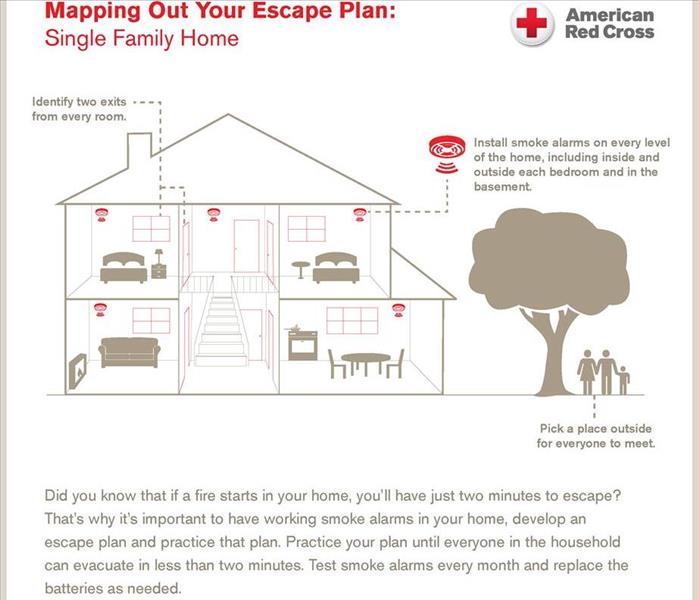 Map your escape plan
Map your escape plan
Courtesy of The American Red Cross
Fast Facts
- Nearly 47,000 fires occur during the winter holidays claiming more than 500 lives, causing more than 2,200 injuries, and costing $554 million in property damage.**
- On average, one of every 22 home fires started by Christmas trees result in death.***
- Candle fires are four times as likely to occur during the winter holidays.**
- During the winter holiday season, an average of 40 home fires per day are caused by children playing.**
- The number of home fires the American Red Cross has responded to has risen 10% since 2000.*
- Having a working smoke alarm reduces one’s chances of dying in a fire by nearly half.**
Preparedness Tips
- Place Christmas trees, candles, and other holiday decorations at least three feet away from heat sources like fireplaces, portable heaters, radiators, heat vents and candles.
- Purchase flame retardant metallic or artificial trees. If you purchase a real tree, make sure that it has fresh, green needles that aren’t easily broken. Keep live trees as moist as possible by giving them plenty of water.
- Make sure that light strings and other holiday decorations are in good condition. Do not use anything with frayed electrical cords and always follow the manufacturer’s instructions.
- Always unplug tree and holiday lights before leaving home or going to bed.
- Never use lit candles to decorate a tree. Always extinguish candles before leaving the room or going to bed.
- Use only sturdy tree stands designed not to tip over. Keep curious pets and children away from Christmas trees.
- Keep anything that can catch on fire—pot holders, oven mitts, wooden utensils, paper or plastic bags, food packaging, and towels or curtains—away from your stove top.
- Designate one person to walk around your home to make sure that all candles and smoking materials are properly extinguished after guests leave.
- Smoke alarms save lives. Install a smoke alarm near your kitchen, on each level of your home, near sleeping areas, and inside and outside bedrooms if you sleep with doors closed. Use the test button to check it each month. Replace all batteries at least once a year.
- Visit www.redcross.org/homefires for more information on how to keep your home fire safe during the holidays.
Sources: American Red Cross,* U.S. Fire Administration,** and the National Fire Protection Association.***
Fire Escape Planning
9/30/2016 (Permalink)
Fire Facts
- One quarter of home fire deaths are caused by fires that start in the bedroom. Another quarter result from fires in the living room, family room or den.
- One-third of survey respondents who made an estimate thought they would have at least 6 minutes before a fire in their home would become life-threatening. The time available is often much less. Only 8 percent said their first thought on hearing a smoke alarm would be to get out.
CAN YOU DO IT IN UNDER 2 MINUTES?
Every second counts during a fire. Fire experts agree, people have as little as two minutes to escape a burning home before it’s too late to get out.* In a matter of moments, a small flame can become a major fire, making it critical to be prepared and have an escape plan in place. A survey conducted by the American Red Cross shows only 26 percent of families have developed and practiced a home fire escape plan. Once a plan is developed, it is critical everyone in the home understands the plan; the best way to do this is by practicing the escape plan at least twice a year. Increase your chance of surviving a fire by ensuring you have working smoke detectors in place, building an escape plan, and then practicing the escape plan. The following are a few suggestions to help you develop an emergency escape plan.
Draw a map of each level of your home and show all doors and windows. Find two ways to get out of each room. Make sure all doors and windows that lead outside open easily.
Consider escape ladders for sleeping areas on the second and third floors. Only purchase collapsible escape ladders evaluated by a recognized testing laboratory. Store them near the window where they will be used.
Choose an outside meeting place a safe distance in front of your home where everyone can meet after they’ve escaped. Make sure to mark the location of the meeting place on your escape plan.
Teach children how to escape on their own in case you cannot help them. Plan for everyone in your home with special considerations for elderly or disabled individuals.
Practice your fire escape plan during the day and at nighttime.
Escape Planning for Your Business
An emergency escape plan is not required for all businesses, however, Occupational Safety and Health Administration (OSHA) recommends building an emergency action plan to protect yourself, your employees, and your business during an emergency. OSHA suggests the following steps when developing such a plan.
Organize an Emergency Preparedness Procedures review with employees to review your company’s emergency plans. You may wish to select an individual or team of individuals to lead and coordinate your emergency plan.
Once a plan is developed, post evacuation procedures, including routes and exits, where they are easily accessible to all employees. Ensure all exits and routes are clearly marked
and well lit, wide enough to accommodate the number of evacuating personnel, and unobstructed and clear of debris at all times.
Conduct office evacuation exercises and drills. Designate a safe spot outside of the facility where employees can regroup, recover and conduct a head count. Once completed, evaluate how well the plan worked and if additional training or exercises are needed.
For more information, visit our website.
Become part of our social community where we provide all kinds of helpful hints on cleaning and home improvement projects:
American Red Cross Fire Prevention Month
9/22/2016 (Permalink)
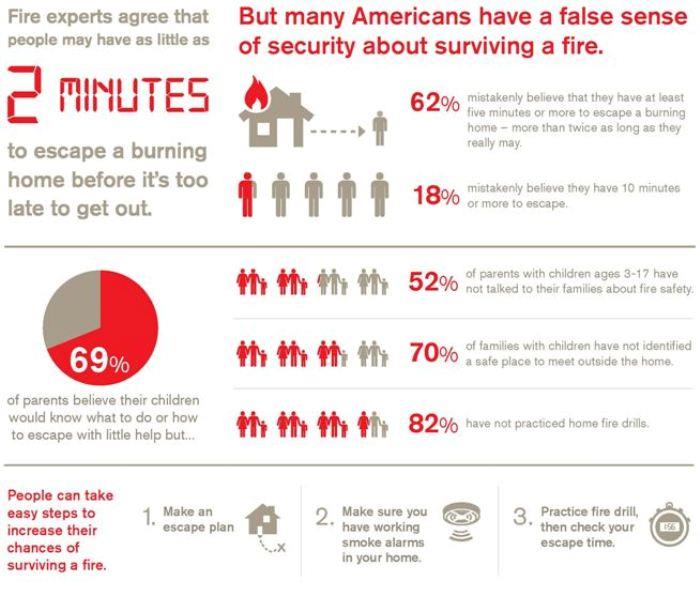 Home Fire Statistics
Home Fire Statistics
Hooray! It’s American Red Cross Fire Prevention Month! For the whole month of October, we are going to help you celebrate by learning more on how to prevent and prepare for home fires with the American Red Cross. For more information, please visit www.redcross.org/get-help/prepare-for-emergencies/types-of-emergeies/fire.
Did you know that home fires are actually the majority of the disasters that occur? You can easily prevent a home fire if you know the right protocol. The American Red Cross has many great tips for you. Please visit www.redcross.org to learn more about preventing home fires and be prepared if one does occur.
Don’t let a home fire happen to you and your family. The American Red Cross can help you learn how tips on how to prevent a home fire at your household. Make sure your family can safely escape your home in less than 2 minutes. Test your smoke alarms. To learn more please visit www.redcross.org/homefires for home fire prevention information. Don’t let a home fire affect your family.
Everyone knows “Stop, drop and roll”. But does everyone know how to escape their house I n less than 2 minutes? To prevent a home fire in your house, please visit the American Red Cross at www.redcross.org/homefires for home fire prevention information. Don’t let a home fire affect your family.
On average, 36 people suffer injuries as a result of home fires every day. To help prevent an injury to you or your loved ones, visit the American Red Cross at www.redcross.org/homefires to learn more information. You can help home fire victims by donating to http://redcross.org/cm/SERVPROindustries-pub
When is the last time you checked your smoke alarm? Make sure you are checking monthly to keep you and your family safe. The American Red Cross will help you learn the other ways to prevent home fires at www.redcross.org/homefires.
Over $7 billion in property damage occurs every year due to home fires. Your help is needed in every form. If you can finally donate please visit, http://redcross.org/cm/SERVPROindustries-pub. If you can give your time or effort, please become an American Red Cross volunteer at www.redcross.org to help others recover from home fires.
Are you home fire safety savvy? Challenge friends, family members, and yourself by taking the quiz at www.redcross.org/homefires.
Teaming with the American Red Cross, we are striving to reduce deaths and injuries due to home fires by 25%. Help us help you. Make sure you know all the proper ways to prevent and prepare for home fires. For more information, please visit www.redcross.org/homefires.
Attention grown ups!! The Red Cross #MonsterGuard app is a great way to teach your kids how to prepare for emergencies. Role playing as monsters, kids learn about different hazards such as home fires, floods and hurricanes. Learn more at www.redcross.org/monsterguard.
You cannot predict when something tragic is going to strike. You can make sure you are prepared when it does. The American Red Cross has great ways to get prepared at www.redcross.org/prepare.
Do you know how often you are supposed to replace your smoke detectors in your house? The American Red Cross does, and to find out the answer, please visit www.redcross.org. It is very important to have updated smoke detectors for your family’s safety.
What is something you can do in less than 2 minutes? You can make a cup of coffee, floss your teeth, but most importantly, evacuate your house in the event of a home fire. For more information on the proper procedure, please visit the American Red Cross at www.redcross.org.
A home is more than a supportive structure. It shelters you, your family, and all of your treasured keepsakes. What if you had the power to prevent the loss of your home? Well, the American Red Cross can give you some of that power by learning proper home fire prevention and safety. For more, please visit www.redcross.org
You can help save lives by having a home fire escape plan. The American Red Cross can help you get your worksheet today by visiting www.redcross.org/escapeplan.
SERVPRO supports the American Red Cross by asking every household in America to join us in taking two simple steps that can save lives; checking or installing smoke alarms and practicing fire drills at home. www.redcross.org
According to the American Red Cross, 82% of family have not practiced fire drills at home. Don’t be a part of that statistic. Practice home fire drills to save your children’s lives. For more information, please visit www.redcross.org
SERVPRO® Pledges Ongoing Support to the American Red Cross Disaster Responder Program
6/16/2016 (Permalink)
Red Cross recognizes SERVPRO for their contribution to disaster preparedness and recovery efforts
The American Red Cross recently recognized SERVPRO®, a cleanup and restoration company, for participation in its Disaster Responder Program1. As a Disaster Responder Program member, SERVPRO pledges a donation to the Red Cross in advance of disasters, allowing the organization to respond quickly and effectively to nearly 66,000 disasters annually, most of which are home fires. SERVPRO is entering their third year of partnership with the Red Cross; their donations to the organization to date exceed one million dollars.
According to statistics cited by the Red Cross, seven people die in a home fire each day in the U.S. Aiming to reduce deaths and injuries caused by home fires by 25 percent by the end of 2019, the Red Cross launched a Home Fire Campaign in October of 2014. The support of SERVPRO and other Disaster Responder Program members allows the Red Cross to pursue their home fire prevention goals while they continue to provide critical services to disaster victims.
“One of the reasons home fires account for the majority of the disasters the Red Cross responds to annually is that the risk for home fires exists all year long,” said John Oliver, owner of SERVPRO of Wayne. “Statistics compiled by the National Fire Protection Association (NFPA)2 show the majority of home fires are related to unattended cooking accidents – and cooking is something most people do every day.”
Although SERVPRO’s business is helping business and home owners recover from fire, flood and other disasters, the company and its franchisees actively support disaster preparedness education, including fire prevention efforts. When disaster does strike, their relationships with major insurance companies combined with industry-leading job-management technology help smooth the path to rebuilding and restoration for home and business owners affected by the unexpected.
“SERVPRO’s commitment to the Red Cross Disaster Responder Program means that, when disaster strikes, homeowners can count on the Red Cross to address their immediate needs and supply essential services,” said Oliver. “Once the immediate emergency is under control, homeowners can count on the expertise of restoration specialists at SERVPRO of Wayne to help them restore their property and move forward with their lives.”
For fire prevention tips and information about fire and water damage restoration services, please visit www.SERVPROwayne.com. For more information on SERVPRO® of Wayne, please contact John Oliver at (973) 546-4977 or office@SERVPROwayne.com.
1 http://www.redcross.org/news/article/local/tennessee/SERVPRO-Recognized-for-Contribution-to-the-American-Red-Cross
2 http://www.nfpa.org/research/reports-and-statistics/fires-by-property-type/residential/home-structure-fires
Home Emergency - Disaster Preparedness
11/20/2015 (Permalink)
Disaster Preparedness - What You Can Do.
In order to be fully prepared, you should have all pertinent and proper information in a written plan for easy retrieval. Some key questions to consider when creating a personal emergency preparedness plan include:�
- Do you have an escape or evacuation route in place?�
- Do you have a designated meeting place in case of separation?
- �Does everyone have a list of contact information including family members out of state who can serve as a point of contact?
- �Do you have a disaster supply kit with necessary supplies?�
- Do you have a first aid kit that includes necessary prescription medicines, over-the-counter medicines and basic medical supplies?�
- Do you have enough non-perishable food and bottled water?�
- Do you have access to important family documents, including insurance policies, bank, credit card and loan information and family records such as birth certificates and social security cards?
- �Do you have an inventory of valuable household goods?
A well-equipped disaster supply kit should include, but is not limited to, the following:�
- Water- a large enough supply to provide each person with 1 gallon daily for drinking and sanitation.�
- Food- enough to last 3-7 days. Food needs to be non-perishable or canned food. You will also want to include a non-electric can opener, paper plates and plastic utensils.�
- Bedding including sheets, blankets and pillows.�
- Clothing- remember it may be warm, however, you may be working and cleaning and may prefer pants or long sleeves to protect your skin. You will also need sturdy, closed-toe, non-slip shoes if available.
- �First aid kit including antiseptics or sanitizers and bandages, over-the-counter and prescription medications.
- Extra flashlights and batteries. Oil lanterns also provide a good source of light, if available.
- �Toiletries including toilet paper and hygiene items. Hand sanitizers are also good to have on hand.
- �Battery-operated radio with extra batteries so you can listen to weather service announcements. �
- Cash- you will want some cash and small bills on hand as banks may not be open.
- �Emergency phone numbers and contact information including insurance agent and family contacts.�
- Tools, tarps, plastic sheets, trash bags, duct tape, etc. to help make minor repairs.
- �Important documents should be kept in a waterproof bag or plastic sealed container and should include insurance, medical and family records, birth certificates, social security cards, bank account information and a complete home inventory analysis.
- �Gas- fill your car’s tank ahead of time if time permits. You may also want to fill plastic gasoline-approved containers with gas to store.�
- Pet care items including food, leash and a carrier or cage.
Don’t wait until it is too late; prepare now to help protect your family in an emergency or disaster situation.
Home Fire Danger Peaks During Holiday Season
11/11/2015 (Permalink)
FOR IMMEDIATE RELEASE
Contact: Jack Oliver
SERVPRO® of Wayne
973-546-4977
office.SERVPROwayne@gmail.com
Home Fire Danger Peaks During Holiday Season
SERVPRO of Wayne cites statistics on escalated cooking and candle fire risk that can turn festivities into a fire drill
Franklin, NJ, November 11, 2015 -- As the holiday season approaches and families gear up for decorating their homes and hosting large gatherings of friends and family, Jack Oliver of SERVPRO of Wayne reminds homeowners to take note of some sobering statistics about home fire safety from the National Fire Prevention Association:
· Cooking equipment is the leading cause of home structure fires. The three peak days for home cooking fires are Thanksgiving, Christmas Day and Christmas Eve.1
· Candles fires peak in December. The top three days for candles fires are Christmas Day, Christmas Eve and New Year’s Eve.2
“These statistics are a serious reminder of how the excitement of holiday entertaining can quickly turn into a life-altering fire or even a tragic injury or death,” says Oliver. “While glowing candles and elaborate meals set the stage for a great holiday get-together, homeowners need to exercise extra care in controlling the dangerous potential for fires.”
According to the NFPA3, unattended cooking is by far the leading cause of home cooking fires, with frying posing the greatest fire risk and electric ranges posing a higher risk than gas ranges. Range top cooking in general started the majority of home cooking fires and caused 86 percent of related civilian deaths for the reporting period.
While incidents of candle fires peaked in 2001 and have been falling since, candles are still one of the top 10 causes of U.S. home fires, according to the NFPA. As with cooking fires, unattended or abandoned candles account for a large portion of candle fires–almost 20 percent–but the most frequent cause of candle fires is placing the candle too close to something that can burn, like curtains, decorations or furniture.
“It’s easy to see why cooking and candle fires both peak during the holiday season,” says Oliver, “and it’s also easy to see why homeowners need to take extra care when decorating their homes or entertaining. A moment’s inattention at the stove or a guest repositioning a candle on a tabletop may be all it takes to turn the festivities into a fight to save property and lives. While our business is fire and water damage restoration and we stand ready to help at a moment’s notice if disaster does strike, our sincere hope is that our friends and neighbors will enjoy a fire-free and festive holiday season.”
For more fire prevention tips and information about fire and water damage restoration services, please visit www.SERVPROwayne.com. For more information on SERVPRO of Wayne, please contact Jack Oliver at 973-546-4977 or office.SERVPROwayne@gmail.com.
http://www.nfpa.org/safety-information/for-consumers/causes/cooking
http://www.nfpa.org/research/reports-and-statistics/fire-causes/candles
http://www.nfpa.org/safety-information/for-consumers/holidays/put-a-freeze-on-winter-fires






 24/7 Emergency Service
24/7 Emergency Service



































